Taxable Amount and Capital Gain Tax Exemption
VerifiedAdded on 2019/12/03
|20
|4991
|140
Report
AI Summary
The provided content discusses the UK taxation system, focusing on individual and business taxes. It explains the working of HMRC, a tax collection agency in the UK, and the roles and responsibilities of tax practitioners. The report also provides examples of calculating tax liabilities for individuals and businesses, including capital gains tax. Additionally, it references various academic articles and online sources to support its findings.
Contribute Materials
Your contribution can guide someone’s learning journey. Share your
documents today.
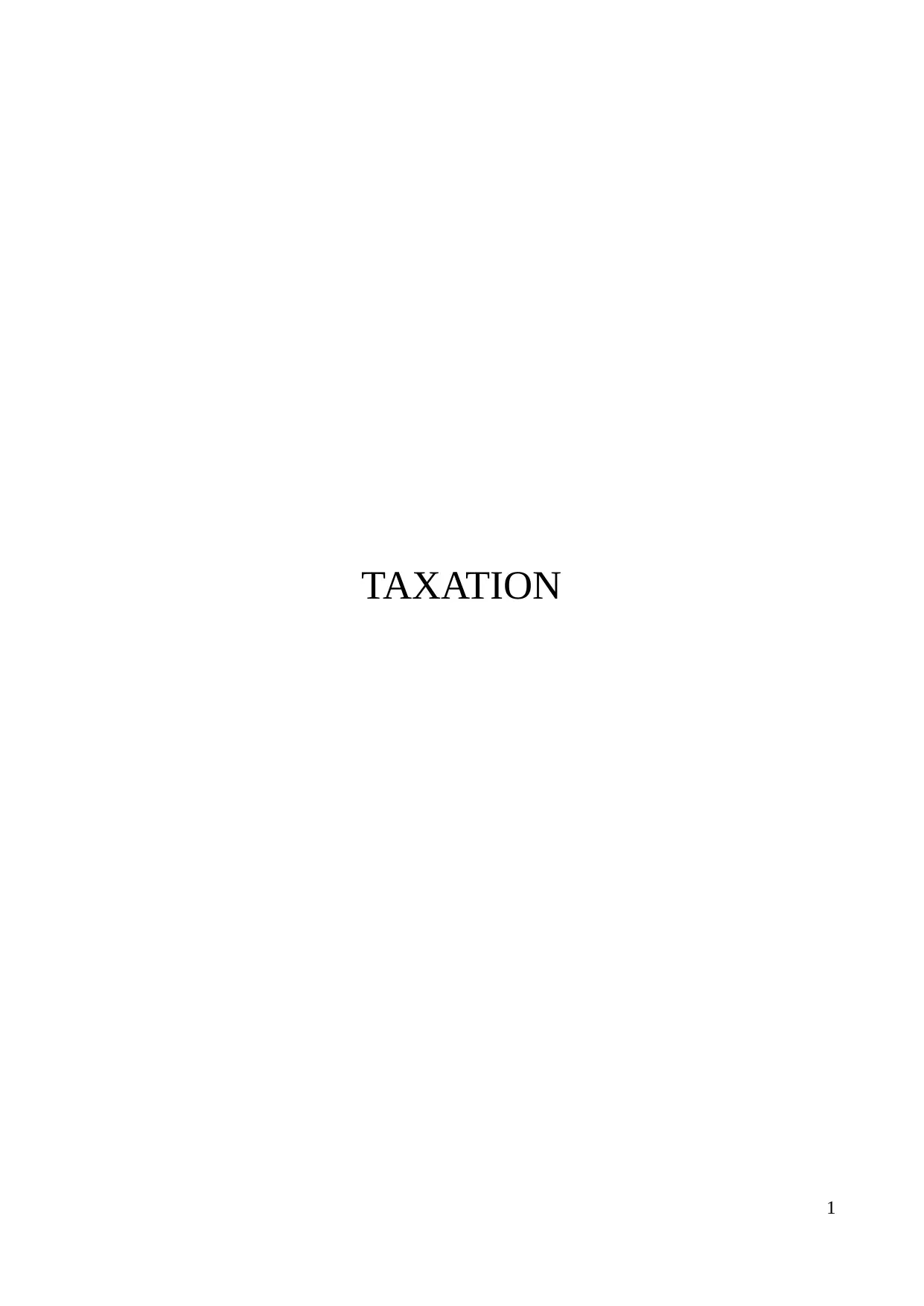
TAXATION
1
1
Secure Best Marks with AI Grader
Need help grading? Try our AI Grader for instant feedback on your assignments.
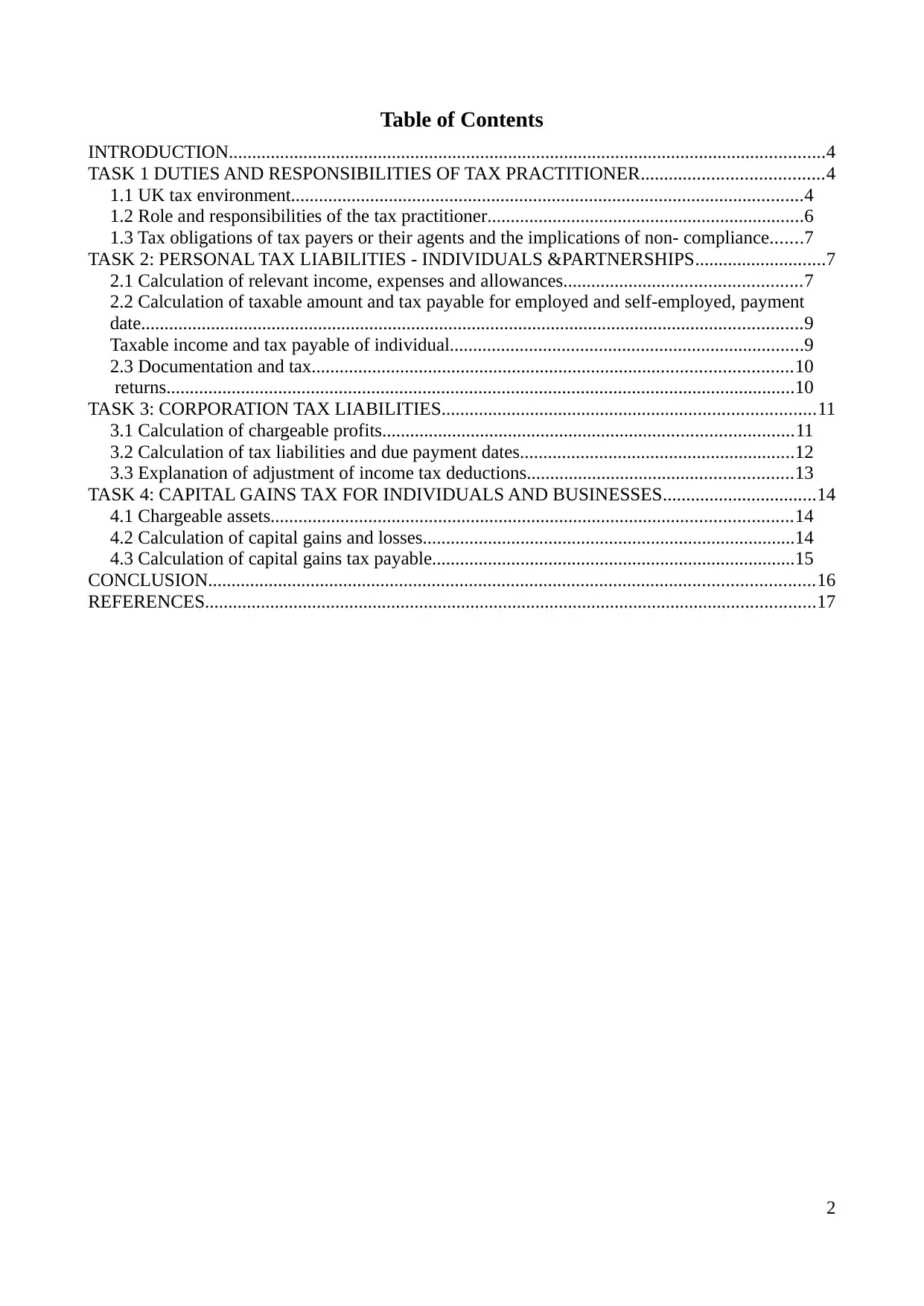
Table of Contents
INTRODUCTION................................................................................................................................4
TASK 1 DUTIES AND RESPONSIBILITIES OF TAX PRACTITIONER.......................................4
1.1 UK tax environment..............................................................................................................4
1.2 Role and responsibilities of the tax practitioner....................................................................6
1.3 Tax obligations of tax payers or their agents and the implications of non- compliance.......7
TASK 2: PERSONAL TAX LIABILITIES - INDIVIDUALS &PARTNERSHIPS............................7
2.1 Calculation of relevant income, expenses and allowances...................................................7
2.2 Calculation of taxable amount and tax payable for employed and self-employed, payment
date..............................................................................................................................................9
Taxable income and tax payable of individual............................................................................9
2.3 Documentation and tax.......................................................................................................10
returns.......................................................................................................................................10
TASK 3: CORPORATION TAX LIABILITIES................................................................................11
3.1 Calculation of chargeable profits........................................................................................11
3.2 Calculation of tax liabilities and due payment dates...........................................................12
3.3 Explanation of adjustment of income tax deductions.........................................................13
TASK 4: CAPITAL GAINS TAX FOR INDIVIDUALS AND BUSINESSES.................................14
4.1 Chargeable assets................................................................................................................14
4.2 Calculation of capital gains and losses................................................................................14
4.3 Calculation of capital gains tax payable..............................................................................15
CONCLUSION..................................................................................................................................16
REFERENCES...................................................................................................................................17
2
INTRODUCTION................................................................................................................................4
TASK 1 DUTIES AND RESPONSIBILITIES OF TAX PRACTITIONER.......................................4
1.1 UK tax environment..............................................................................................................4
1.2 Role and responsibilities of the tax practitioner....................................................................6
1.3 Tax obligations of tax payers or their agents and the implications of non- compliance.......7
TASK 2: PERSONAL TAX LIABILITIES - INDIVIDUALS &PARTNERSHIPS............................7
2.1 Calculation of relevant income, expenses and allowances...................................................7
2.2 Calculation of taxable amount and tax payable for employed and self-employed, payment
date..............................................................................................................................................9
Taxable income and tax payable of individual............................................................................9
2.3 Documentation and tax.......................................................................................................10
returns.......................................................................................................................................10
TASK 3: CORPORATION TAX LIABILITIES................................................................................11
3.1 Calculation of chargeable profits........................................................................................11
3.2 Calculation of tax liabilities and due payment dates...........................................................12
3.3 Explanation of adjustment of income tax deductions.........................................................13
TASK 4: CAPITAL GAINS TAX FOR INDIVIDUALS AND BUSINESSES.................................14
4.1 Chargeable assets................................................................................................................14
4.2 Calculation of capital gains and losses................................................................................14
4.3 Calculation of capital gains tax payable..............................................................................15
CONCLUSION..................................................................................................................................16
REFERENCES...................................................................................................................................17
2
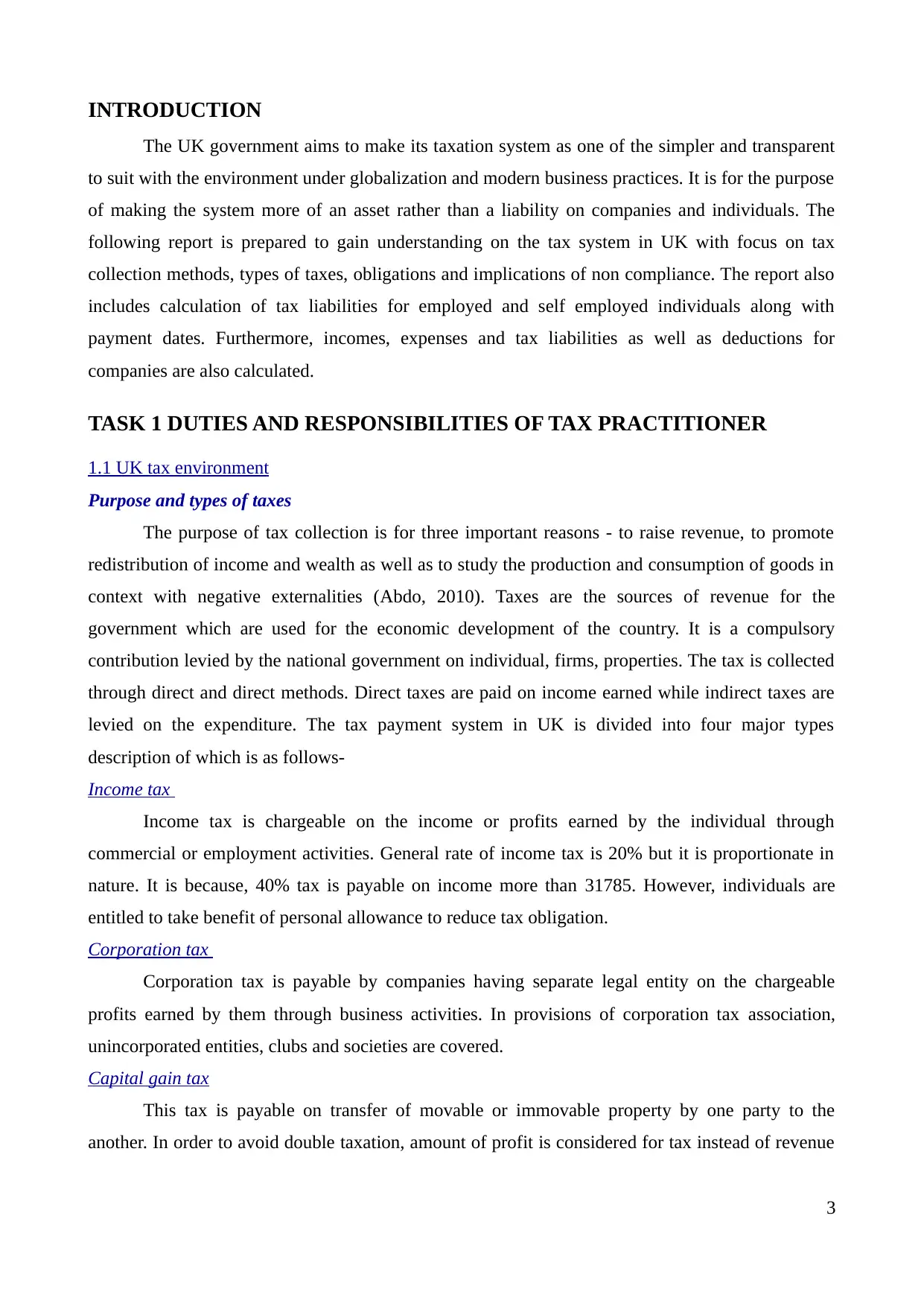
INTRODUCTION
The UK government aims to make its taxation system as one of the simpler and transparent
to suit with the environment under globalization and modern business practices. It is for the purpose
of making the system more of an asset rather than a liability on companies and individuals. The
following report is prepared to gain understanding on the tax system in UK with focus on tax
collection methods, types of taxes, obligations and implications of non compliance. The report also
includes calculation of tax liabilities for employed and self employed individuals along with
payment dates. Furthermore, incomes, expenses and tax liabilities as well as deductions for
companies are also calculated.
TASK 1 DUTIES AND RESPONSIBILITIES OF TAX PRACTITIONER
1.1 UK tax environment
Purpose and types of taxes
The purpose of tax collection is for three important reasons - to raise revenue, to promote
redistribution of income and wealth as well as to study the production and consumption of goods in
context with negative externalities (Abdo, 2010). Taxes are the sources of revenue for the
government which are used for the economic development of the country. It is a compulsory
contribution levied by the national government on individual, firms, properties. The tax is collected
through direct and direct methods. Direct taxes are paid on income earned while indirect taxes are
levied on the expenditure. The tax payment system in UK is divided into four major types
description of which is as follows-
Income tax
Income tax is chargeable on the income or profits earned by the individual through
commercial or employment activities. General rate of income tax is 20% but it is proportionate in
nature. It is because, 40% tax is payable on income more than 31785. However, individuals are
entitled to take benefit of personal allowance to reduce tax obligation.
Corporation tax
Corporation tax is payable by companies having separate legal entity on the chargeable
profits earned by them through business activities. In provisions of corporation tax association,
unincorporated entities, clubs and societies are covered.
Capital gain tax
This tax is payable on transfer of movable or immovable property by one party to the
another. In order to avoid double taxation, amount of profit is considered for tax instead of revenue
3
The UK government aims to make its taxation system as one of the simpler and transparent
to suit with the environment under globalization and modern business practices. It is for the purpose
of making the system more of an asset rather than a liability on companies and individuals. The
following report is prepared to gain understanding on the tax system in UK with focus on tax
collection methods, types of taxes, obligations and implications of non compliance. The report also
includes calculation of tax liabilities for employed and self employed individuals along with
payment dates. Furthermore, incomes, expenses and tax liabilities as well as deductions for
companies are also calculated.
TASK 1 DUTIES AND RESPONSIBILITIES OF TAX PRACTITIONER
1.1 UK tax environment
Purpose and types of taxes
The purpose of tax collection is for three important reasons - to raise revenue, to promote
redistribution of income and wealth as well as to study the production and consumption of goods in
context with negative externalities (Abdo, 2010). Taxes are the sources of revenue for the
government which are used for the economic development of the country. It is a compulsory
contribution levied by the national government on individual, firms, properties. The tax is collected
through direct and direct methods. Direct taxes are paid on income earned while indirect taxes are
levied on the expenditure. The tax payment system in UK is divided into four major types
description of which is as follows-
Income tax
Income tax is chargeable on the income or profits earned by the individual through
commercial or employment activities. General rate of income tax is 20% but it is proportionate in
nature. It is because, 40% tax is payable on income more than 31785. However, individuals are
entitled to take benefit of personal allowance to reduce tax obligation.
Corporation tax
Corporation tax is payable by companies having separate legal entity on the chargeable
profits earned by them through business activities. In provisions of corporation tax association,
unincorporated entities, clubs and societies are covered.
Capital gain tax
This tax is payable on transfer of movable or immovable property by one party to the
another. In order to avoid double taxation, amount of profit is considered for tax instead of revenue
3
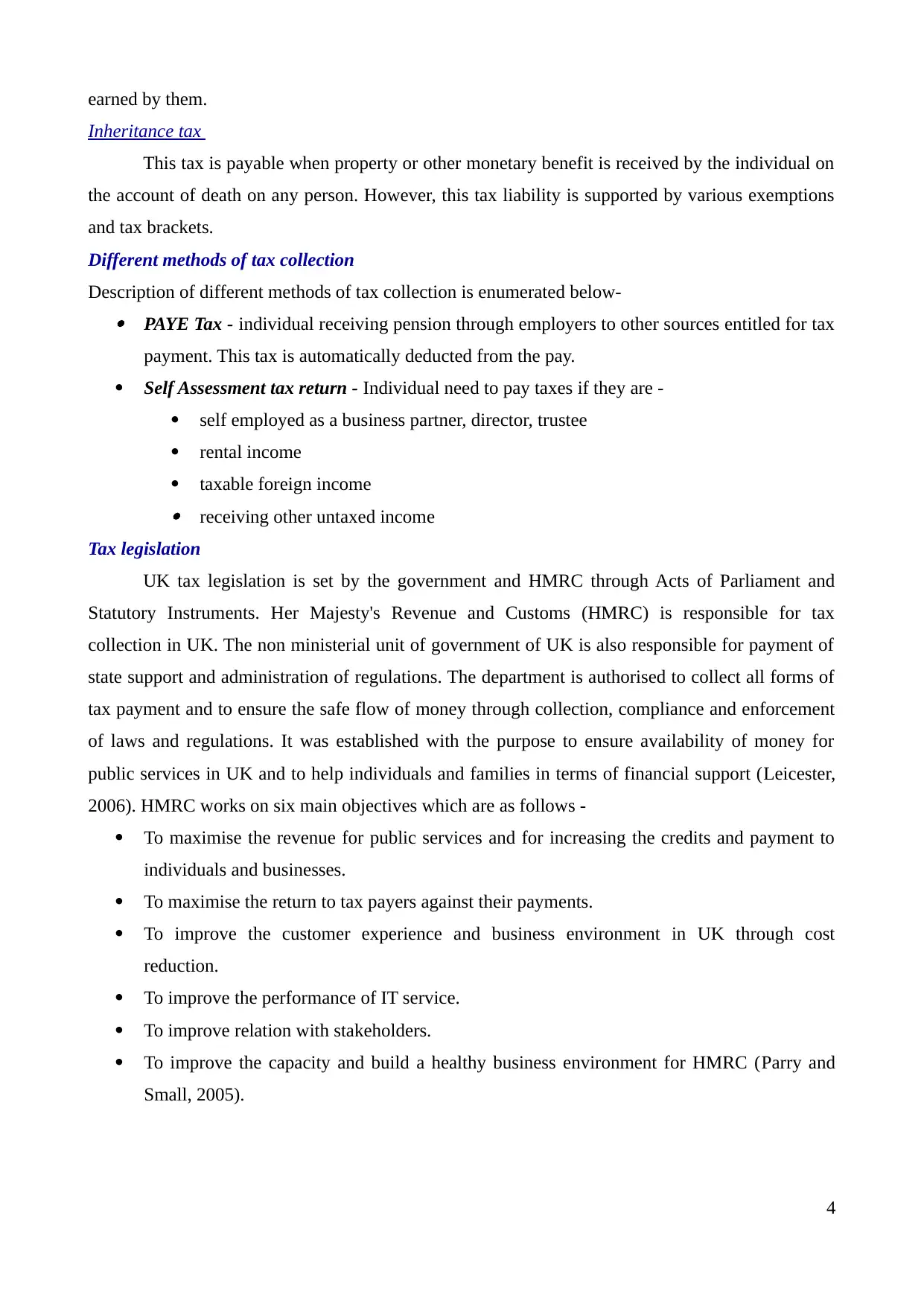
earned by them.
Inheritance tax
This tax is payable when property or other monetary benefit is received by the individual on
the account of death on any person. However, this tax liability is supported by various exemptions
and tax brackets.
Different methods of tax collection
Description of different methods of tax collection is enumerated below- PAYE Tax - individual receiving pension through employers to other sources entitled for tax
payment. This tax is automatically deducted from the pay.
Self Assessment tax return - Individual need to pay taxes if they are -
self employed as a business partner, director, trustee
rental income
taxable foreign income
receiving other untaxed income
Tax legislation
UK tax legislation is set by the government and HMRC through Acts of Parliament and
Statutory Instruments. Her Majesty's Revenue and Customs (HMRC) is responsible for tax
collection in UK. The non ministerial unit of government of UK is also responsible for payment of
state support and administration of regulations. The department is authorised to collect all forms of
tax payment and to ensure the safe flow of money through collection, compliance and enforcement
of laws and regulations. It was established with the purpose to ensure availability of money for
public services in UK and to help individuals and families in terms of financial support (Leicester,
2006). HMRC works on six main objectives which are as follows -
To maximise the revenue for public services and for increasing the credits and payment to
individuals and businesses.
To maximise the return to tax payers against their payments.
To improve the customer experience and business environment in UK through cost
reduction.
To improve the performance of IT service.
To improve relation with stakeholders.
To improve the capacity and build a healthy business environment for HMRC (Parry and
Small, 2005).
4
Inheritance tax
This tax is payable when property or other monetary benefit is received by the individual on
the account of death on any person. However, this tax liability is supported by various exemptions
and tax brackets.
Different methods of tax collection
Description of different methods of tax collection is enumerated below- PAYE Tax - individual receiving pension through employers to other sources entitled for tax
payment. This tax is automatically deducted from the pay.
Self Assessment tax return - Individual need to pay taxes if they are -
self employed as a business partner, director, trustee
rental income
taxable foreign income
receiving other untaxed income
Tax legislation
UK tax legislation is set by the government and HMRC through Acts of Parliament and
Statutory Instruments. Her Majesty's Revenue and Customs (HMRC) is responsible for tax
collection in UK. The non ministerial unit of government of UK is also responsible for payment of
state support and administration of regulations. The department is authorised to collect all forms of
tax payment and to ensure the safe flow of money through collection, compliance and enforcement
of laws and regulations. It was established with the purpose to ensure availability of money for
public services in UK and to help individuals and families in terms of financial support (Leicester,
2006). HMRC works on six main objectives which are as follows -
To maximise the revenue for public services and for increasing the credits and payment to
individuals and businesses.
To maximise the return to tax payers against their payments.
To improve the customer experience and business environment in UK through cost
reduction.
To improve the performance of IT service.
To improve relation with stakeholders.
To improve the capacity and build a healthy business environment for HMRC (Parry and
Small, 2005).
4
Secure Best Marks with AI Grader
Need help grading? Try our AI Grader for instant feedback on your assignments.
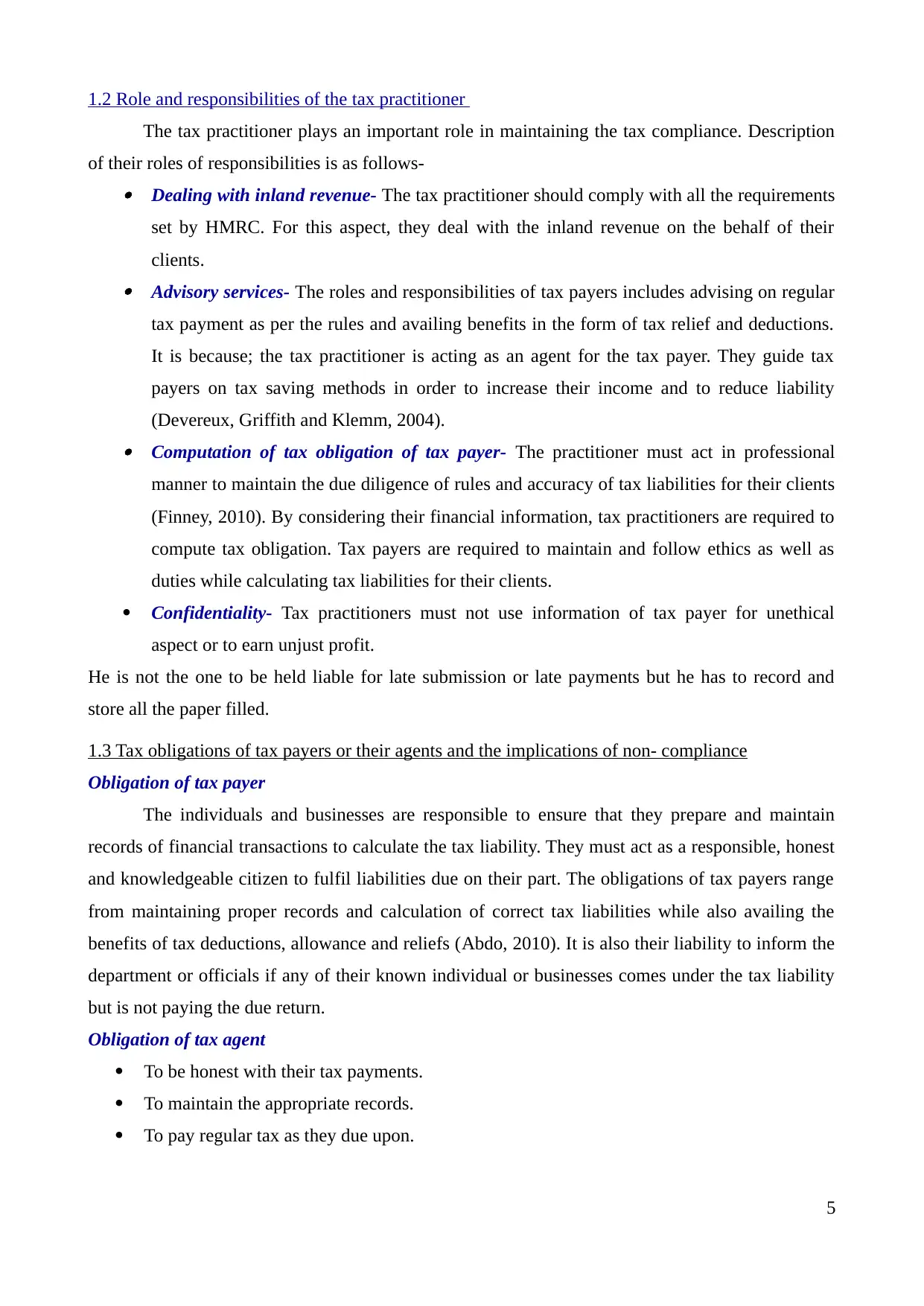
1.2 Role and responsibilities of the tax practitioner
The tax practitioner plays an important role in maintaining the tax compliance. Description
of their roles of responsibilities is as follows- Dealing with inland revenue- The tax practitioner should comply with all the requirements
set by HMRC. For this aspect, they deal with the inland revenue on the behalf of their
clients. Advisory services- The roles and responsibilities of tax payers includes advising on regular
tax payment as per the rules and availing benefits in the form of tax relief and deductions.
It is because; the tax practitioner is acting as an agent for the tax payer. They guide tax
payers on tax saving methods in order to increase their income and to reduce liability
(Devereux, Griffith and Klemm, 2004). Computation of tax obligation of tax payer- The practitioner must act in professional
manner to maintain the due diligence of rules and accuracy of tax liabilities for their clients
(Finney, 2010). By considering their financial information, tax practitioners are required to
compute tax obligation. Tax payers are required to maintain and follow ethics as well as
duties while calculating tax liabilities for their clients.
Confidentiality- Tax practitioners must not use information of tax payer for unethical
aspect or to earn unjust profit.
He is not the one to be held liable for late submission or late payments but he has to record and
store all the paper filled.
1.3 Tax obligations of tax payers or their agents and the implications of non- compliance
Obligation of tax payer
The individuals and businesses are responsible to ensure that they prepare and maintain
records of financial transactions to calculate the tax liability. They must act as a responsible, honest
and knowledgeable citizen to fulfil liabilities due on their part. The obligations of tax payers range
from maintaining proper records and calculation of correct tax liabilities while also availing the
benefits of tax deductions, allowance and reliefs (Abdo, 2010). It is also their liability to inform the
department or officials if any of their known individual or businesses comes under the tax liability
but is not paying the due return.
Obligation of tax agent
To be honest with their tax payments.
To maintain the appropriate records.
To pay regular tax as they due upon.
5
The tax practitioner plays an important role in maintaining the tax compliance. Description
of their roles of responsibilities is as follows- Dealing with inland revenue- The tax practitioner should comply with all the requirements
set by HMRC. For this aspect, they deal with the inland revenue on the behalf of their
clients. Advisory services- The roles and responsibilities of tax payers includes advising on regular
tax payment as per the rules and availing benefits in the form of tax relief and deductions.
It is because; the tax practitioner is acting as an agent for the tax payer. They guide tax
payers on tax saving methods in order to increase their income and to reduce liability
(Devereux, Griffith and Klemm, 2004). Computation of tax obligation of tax payer- The practitioner must act in professional
manner to maintain the due diligence of rules and accuracy of tax liabilities for their clients
(Finney, 2010). By considering their financial information, tax practitioners are required to
compute tax obligation. Tax payers are required to maintain and follow ethics as well as
duties while calculating tax liabilities for their clients.
Confidentiality- Tax practitioners must not use information of tax payer for unethical
aspect or to earn unjust profit.
He is not the one to be held liable for late submission or late payments but he has to record and
store all the paper filled.
1.3 Tax obligations of tax payers or their agents and the implications of non- compliance
Obligation of tax payer
The individuals and businesses are responsible to ensure that they prepare and maintain
records of financial transactions to calculate the tax liability. They must act as a responsible, honest
and knowledgeable citizen to fulfil liabilities due on their part. The obligations of tax payers range
from maintaining proper records and calculation of correct tax liabilities while also availing the
benefits of tax deductions, allowance and reliefs (Abdo, 2010). It is also their liability to inform the
department or officials if any of their known individual or businesses comes under the tax liability
but is not paying the due return.
Obligation of tax agent
To be honest with their tax payments.
To maintain the appropriate records.
To pay regular tax as they due upon.
5
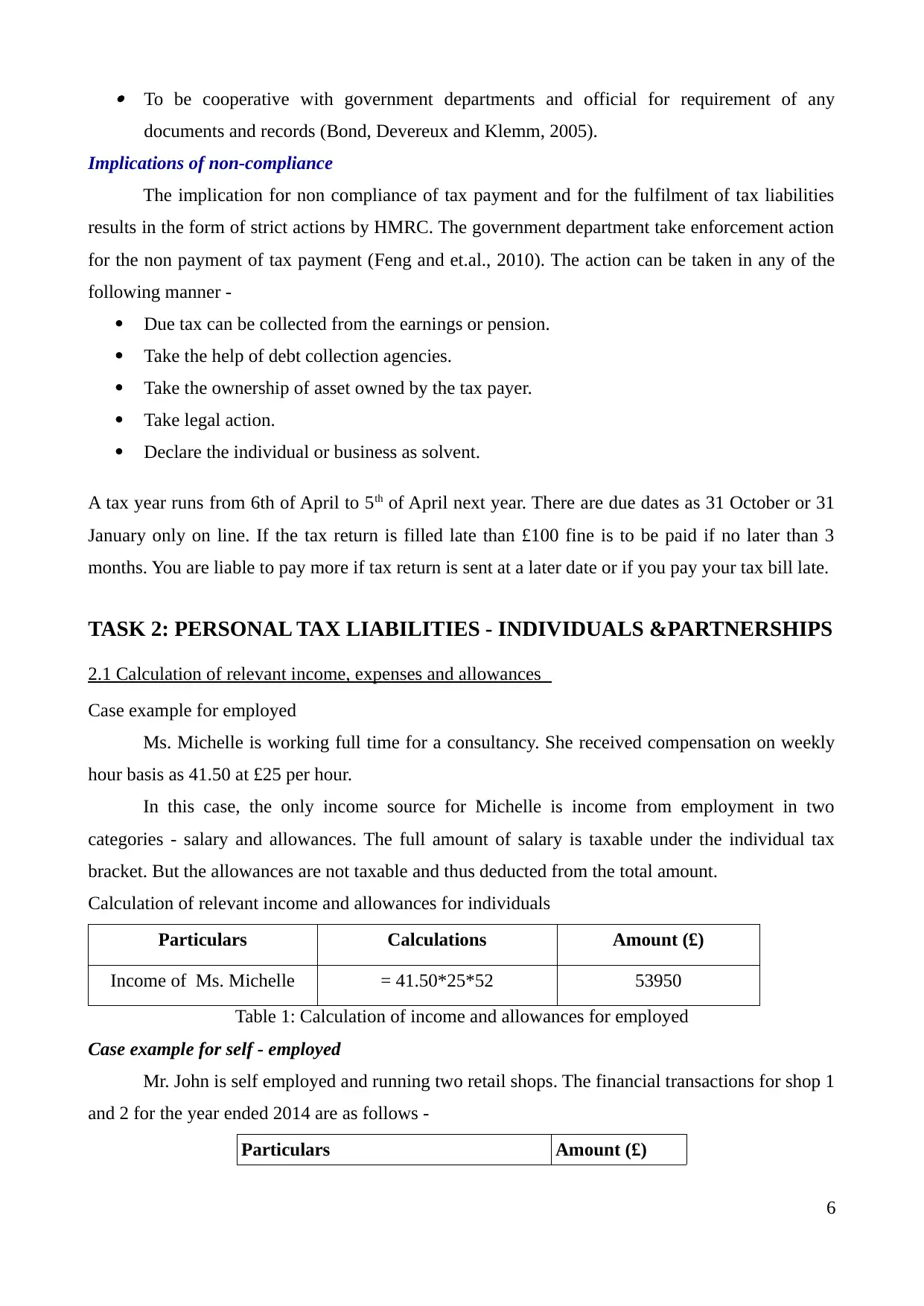
To be cooperative with government departments and official for requirement of any
documents and records (Bond, Devereux and Klemm, 2005).
Implications of non-compliance
The implication for non compliance of tax payment and for the fulfilment of tax liabilities
results in the form of strict actions by HMRC. The government department take enforcement action
for the non payment of tax payment (Feng and et.al., 2010). The action can be taken in any of the
following manner -
Due tax can be collected from the earnings or pension.
Take the help of debt collection agencies.
Take the ownership of asset owned by the tax payer.
Take legal action.
Declare the individual or business as solvent.
A tax year runs from 6th of April to 5th of April next year. There are due dates as 31 October or 31
January only on line. If the tax return is filled late than £100 fine is to be paid if no later than 3
months. You are liable to pay more if tax return is sent at a later date or if you pay your tax bill late.
TASK 2: PERSONAL TAX LIABILITIES - INDIVIDUALS &PARTNERSHIPS
2.1 Calculation of relevant income, expenses and allowances
Case example for employed
Ms. Michelle is working full time for a consultancy. She received compensation on weekly
hour basis as 41.50 at £25 per hour.
In this case, the only income source for Michelle is income from employment in two
categories - salary and allowances. The full amount of salary is taxable under the individual tax
bracket. But the allowances are not taxable and thus deducted from the total amount.
Calculation of relevant income and allowances for individuals
Particulars Calculations Amount (£)
Income of Ms. Michelle = 41.50*25*52 53950
Table 1: Calculation of income and allowances for employed
Case example for self - employed
Mr. John is self employed and running two retail shops. The financial transactions for shop 1
and 2 for the year ended 2014 are as follows -
Particulars Amount (£)
6
documents and records (Bond, Devereux and Klemm, 2005).
Implications of non-compliance
The implication for non compliance of tax payment and for the fulfilment of tax liabilities
results in the form of strict actions by HMRC. The government department take enforcement action
for the non payment of tax payment (Feng and et.al., 2010). The action can be taken in any of the
following manner -
Due tax can be collected from the earnings or pension.
Take the help of debt collection agencies.
Take the ownership of asset owned by the tax payer.
Take legal action.
Declare the individual or business as solvent.
A tax year runs from 6th of April to 5th of April next year. There are due dates as 31 October or 31
January only on line. If the tax return is filled late than £100 fine is to be paid if no later than 3
months. You are liable to pay more if tax return is sent at a later date or if you pay your tax bill late.
TASK 2: PERSONAL TAX LIABILITIES - INDIVIDUALS &PARTNERSHIPS
2.1 Calculation of relevant income, expenses and allowances
Case example for employed
Ms. Michelle is working full time for a consultancy. She received compensation on weekly
hour basis as 41.50 at £25 per hour.
In this case, the only income source for Michelle is income from employment in two
categories - salary and allowances. The full amount of salary is taxable under the individual tax
bracket. But the allowances are not taxable and thus deducted from the total amount.
Calculation of relevant income and allowances for individuals
Particulars Calculations Amount (£)
Income of Ms. Michelle = 41.50*25*52 53950
Table 1: Calculation of income and allowances for employed
Case example for self - employed
Mr. John is self employed and running two retail shops. The financial transactions for shop 1
and 2 for the year ended 2014 are as follows -
Particulars Amount (£)
6
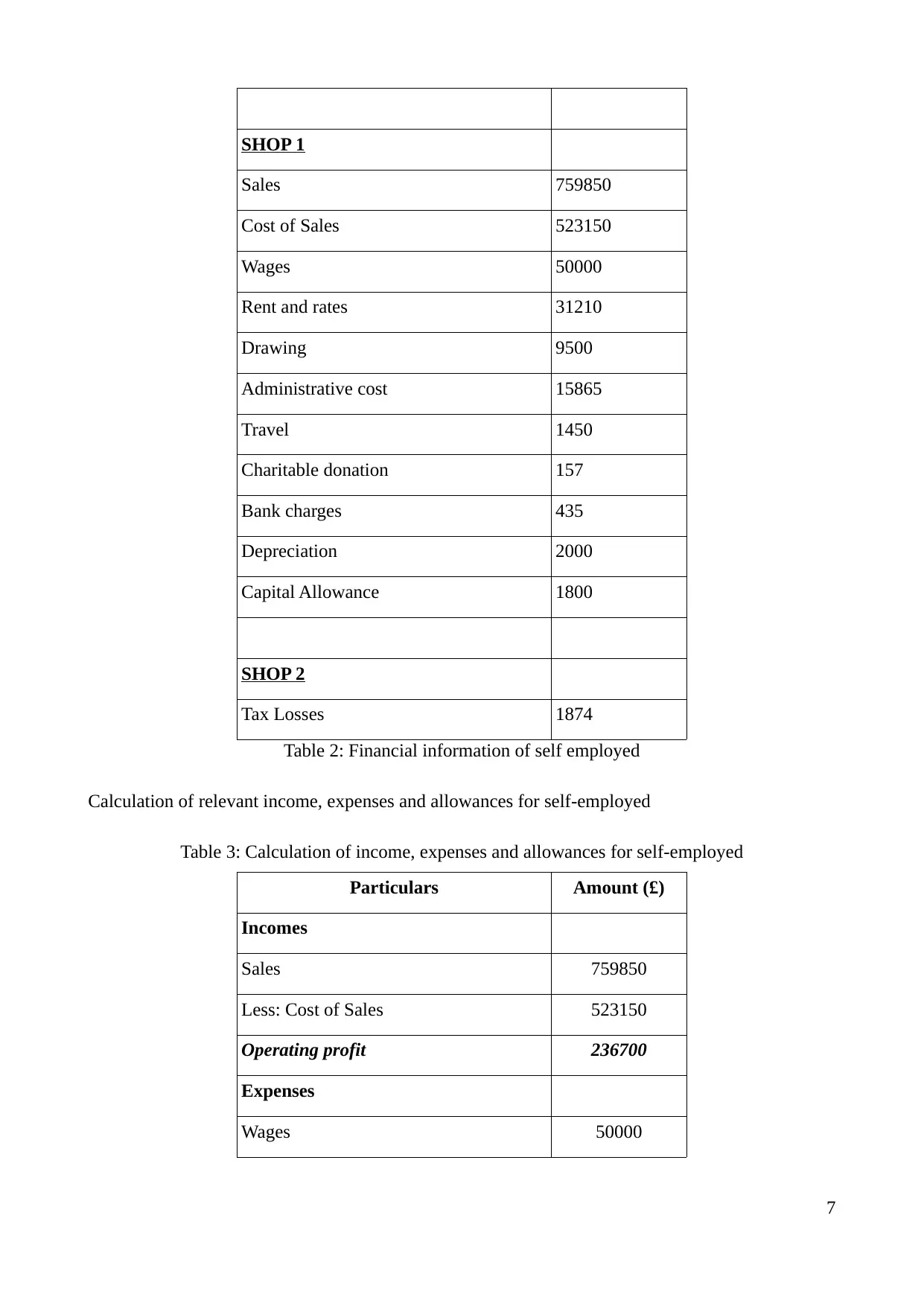
SHOP 1
Sales 759850
Cost of Sales 523150
Wages 50000
Rent and rates 31210
Drawing 9500
Administrative cost 15865
Travel 1450
Charitable donation 157
Bank charges 435
Depreciation 2000
Capital Allowance 1800
SHOP 2
Tax Losses 1874
Table 2: Financial information of self employed
Calculation of relevant income, expenses and allowances for self-employed
Table 3: Calculation of income, expenses and allowances for self-employed
Particulars Amount (£)
Incomes
Sales 759850
Less: Cost of Sales 523150
Operating profit 236700
Expenses
Wages 50000
7
Sales 759850
Cost of Sales 523150
Wages 50000
Rent and rates 31210
Drawing 9500
Administrative cost 15865
Travel 1450
Charitable donation 157
Bank charges 435
Depreciation 2000
Capital Allowance 1800
SHOP 2
Tax Losses 1874
Table 2: Financial information of self employed
Calculation of relevant income, expenses and allowances for self-employed
Table 3: Calculation of income, expenses and allowances for self-employed
Particulars Amount (£)
Incomes
Sales 759850
Less: Cost of Sales 523150
Operating profit 236700
Expenses
Wages 50000
7
Paraphrase This Document
Need a fresh take? Get an instant paraphrase of this document with our AI Paraphraser
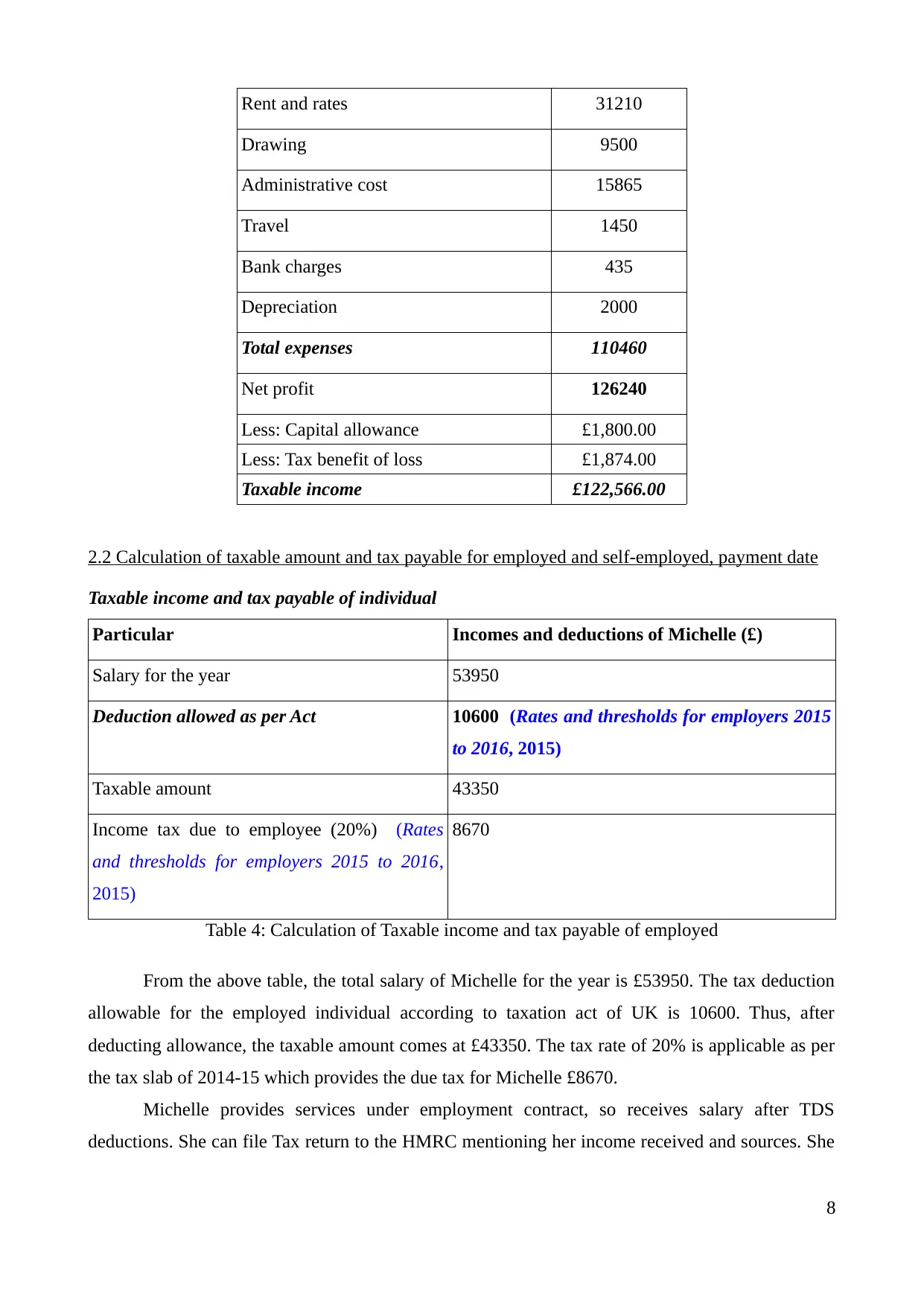
Rent and rates 31210
Drawing 9500
Administrative cost 15865
Travel 1450
Bank charges 435
Depreciation 2000
Total expenses 110460
Net profit 126240
Less: Capital allowance £1,800.00
Less: Tax benefit of loss £1,874.00
Taxable income £122,566.00
2.2 Calculation of taxable amount and tax payable for employed and self-employed, payment date
Taxable income and tax payable of individual
Particular Incomes and deductions of Michelle (£)
Salary for the year 53950
Deduction allowed as per Act 10600 (Rates and thresholds for employers 2015
to 2016, 2015)
Taxable amount 43350
Income tax due to employee (20%) (Rates
and thresholds for employers 2015 to 2016,
2015)
8670
Table 4: Calculation of Taxable income and tax payable of employed
From the above table, the total salary of Michelle for the year is £53950. The tax deduction
allowable for the employed individual according to taxation act of UK is 10600. Thus, after
deducting allowance, the taxable amount comes at £43350. The tax rate of 20% is applicable as per
the tax slab of 2014-15 which provides the due tax for Michelle £8670.
Michelle provides services under employment contract, so receives salary after TDS
deductions. She can file Tax return to the HMRC mentioning her income received and sources. She
8
Drawing 9500
Administrative cost 15865
Travel 1450
Bank charges 435
Depreciation 2000
Total expenses 110460
Net profit 126240
Less: Capital allowance £1,800.00
Less: Tax benefit of loss £1,874.00
Taxable income £122,566.00
2.2 Calculation of taxable amount and tax payable for employed and self-employed, payment date
Taxable income and tax payable of individual
Particular Incomes and deductions of Michelle (£)
Salary for the year 53950
Deduction allowed as per Act 10600 (Rates and thresholds for employers 2015
to 2016, 2015)
Taxable amount 43350
Income tax due to employee (20%) (Rates
and thresholds for employers 2015 to 2016,
2015)
8670
Table 4: Calculation of Taxable income and tax payable of employed
From the above table, the total salary of Michelle for the year is £53950. The tax deduction
allowable for the employed individual according to taxation act of UK is 10600. Thus, after
deducting allowance, the taxable amount comes at £43350. The tax rate of 20% is applicable as per
the tax slab of 2014-15 which provides the due tax for Michelle £8670.
Michelle provides services under employment contract, so receives salary after TDS
deductions. She can file Tax return to the HMRC mentioning her income received and sources. She
8
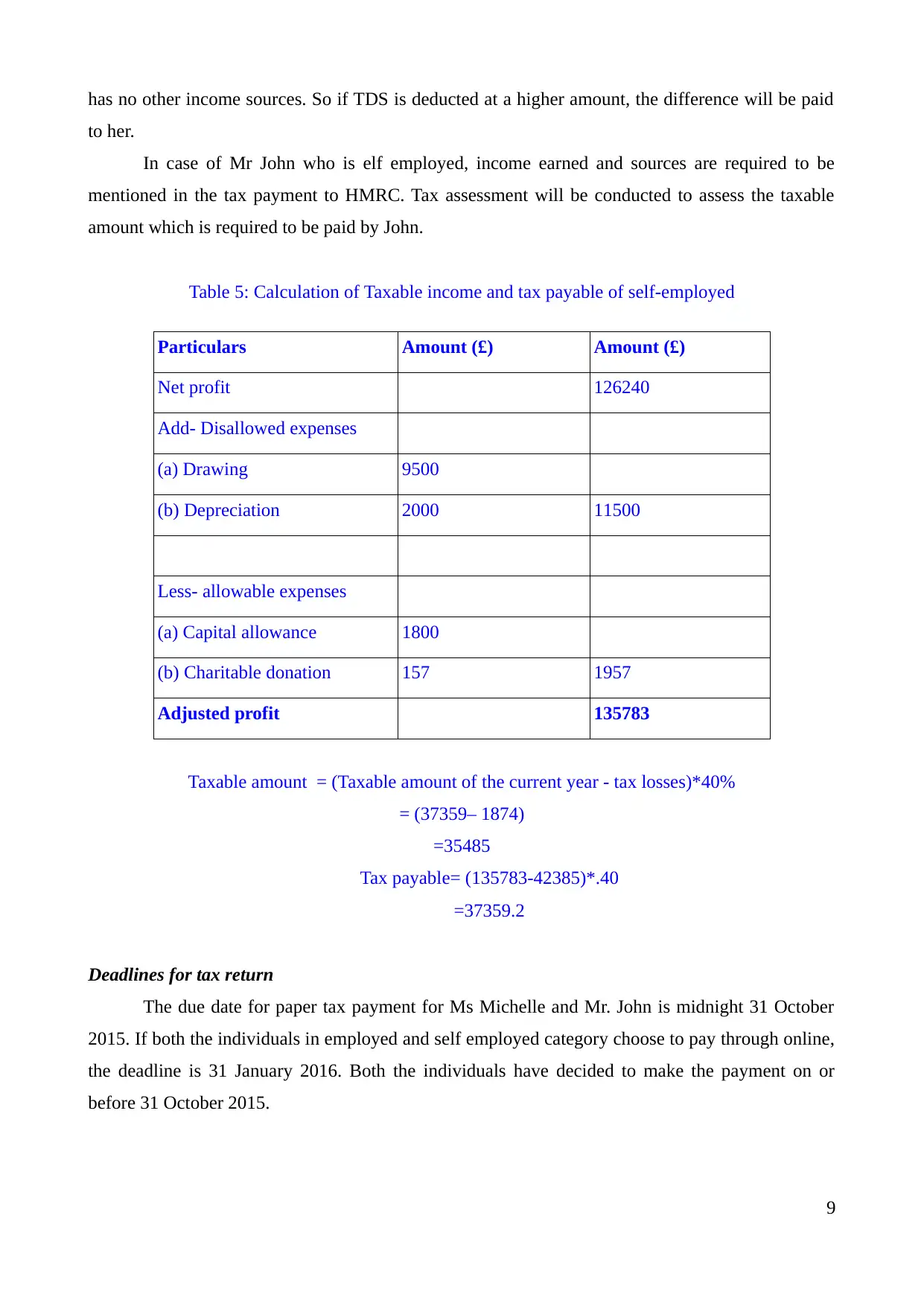
has no other income sources. So if TDS is deducted at a higher amount, the difference will be paid
to her.
In case of Mr John who is elf employed, income earned and sources are required to be
mentioned in the tax payment to HMRC. Tax assessment will be conducted to assess the taxable
amount which is required to be paid by John.
Table 5: Calculation of Taxable income and tax payable of self-employed
Particulars Amount (£) Amount (£)
Net profit 126240
Add- Disallowed expenses
(a) Drawing 9500
(b) Depreciation 2000 11500
Less- allowable expenses
(a) Capital allowance 1800
(b) Charitable donation 157 1957
Adjusted profit 135783
Taxable amount = (Taxable amount of the current year - tax losses)*40%
= (37359– 1874)
=35485
Tax payable= (135783-42385)*.40
=37359.2
Deadlines for tax return
The due date for paper tax payment for Ms Michelle and Mr. John is midnight 31 October
2015. If both the individuals in employed and self employed category choose to pay through online,
the deadline is 31 January 2016. Both the individuals have decided to make the payment on or
before 31 October 2015.
9
to her.
In case of Mr John who is elf employed, income earned and sources are required to be
mentioned in the tax payment to HMRC. Tax assessment will be conducted to assess the taxable
amount which is required to be paid by John.
Table 5: Calculation of Taxable income and tax payable of self-employed
Particulars Amount (£) Amount (£)
Net profit 126240
Add- Disallowed expenses
(a) Drawing 9500
(b) Depreciation 2000 11500
Less- allowable expenses
(a) Capital allowance 1800
(b) Charitable donation 157 1957
Adjusted profit 135783
Taxable amount = (Taxable amount of the current year - tax losses)*40%
= (37359– 1874)
=35485
Tax payable= (135783-42385)*.40
=37359.2
Deadlines for tax return
The due date for paper tax payment for Ms Michelle and Mr. John is midnight 31 October
2015. If both the individuals in employed and self employed category choose to pay through online,
the deadline is 31 January 2016. Both the individuals have decided to make the payment on or
before 31 October 2015.
9
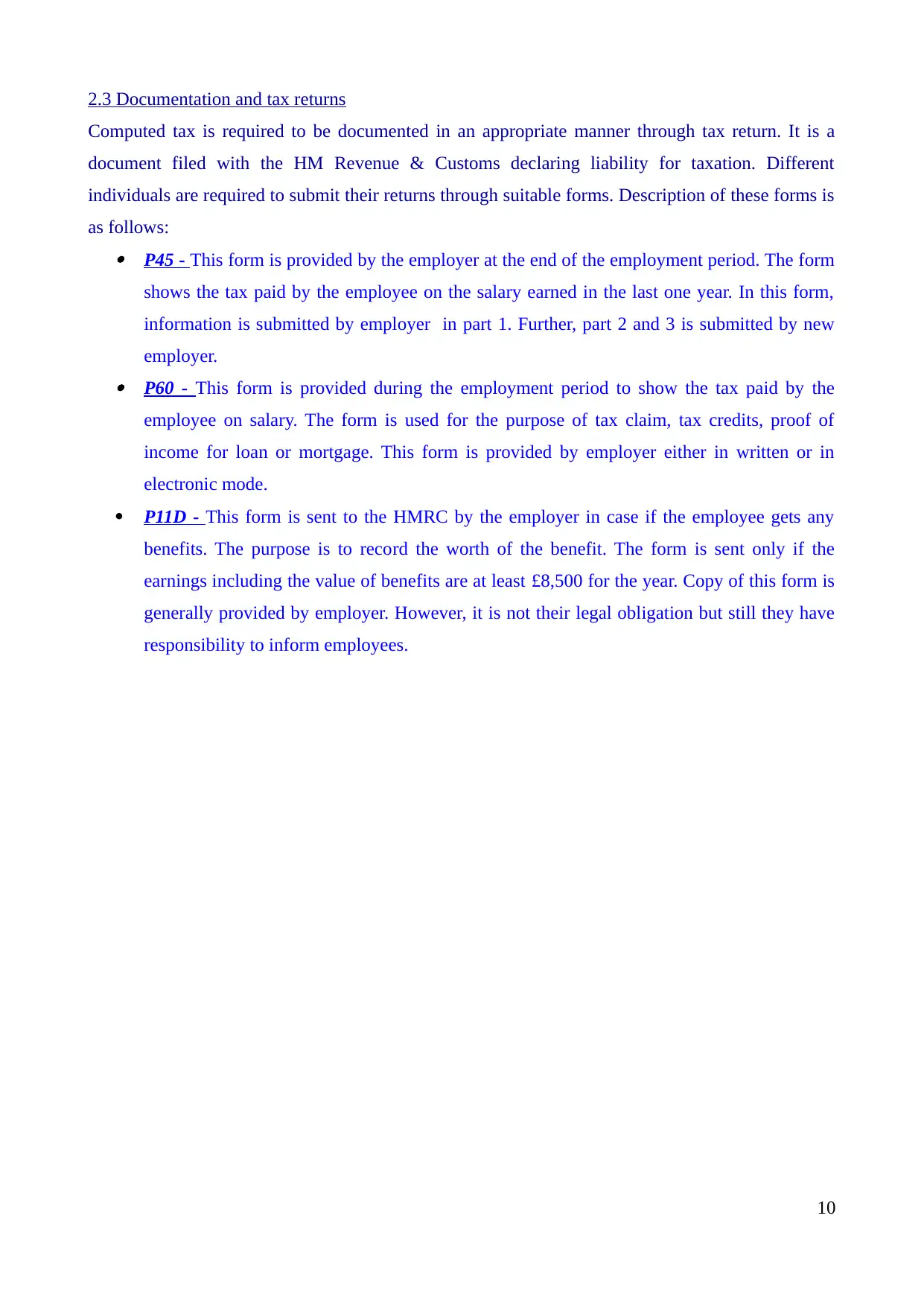
2.3 Documentation and tax returns
Computed tax is required to be documented in an appropriate manner through tax return. It is a
document filed with the HM Revenue & Customs declaring liability for taxation. Different
individuals are required to submit their returns through suitable forms. Description of these forms is
as follows: P45 - This form is provided by the employer at the end of the employment period. The form
shows the tax paid by the employee on the salary earned in the last one year. In this form,
information is submitted by employer in part 1. Further, part 2 and 3 is submitted by new
employer. P60 - This form is provided during the employment period to show the tax paid by the
employee on salary. The form is used for the purpose of tax claim, tax credits, proof of
income for loan or mortgage. This form is provided by employer either in written or in
electronic mode.
P11D - This form is sent to the HMRC by the employer in case if the employee gets any
benefits. The purpose is to record the worth of the benefit. The form is sent only if the
earnings including the value of benefits are at least £8,500 for the year. Copy of this form is
generally provided by employer. However, it is not their legal obligation but still they have
responsibility to inform employees.
10
Computed tax is required to be documented in an appropriate manner through tax return. It is a
document filed with the HM Revenue & Customs declaring liability for taxation. Different
individuals are required to submit their returns through suitable forms. Description of these forms is
as follows: P45 - This form is provided by the employer at the end of the employment period. The form
shows the tax paid by the employee on the salary earned in the last one year. In this form,
information is submitted by employer in part 1. Further, part 2 and 3 is submitted by new
employer. P60 - This form is provided during the employment period to show the tax paid by the
employee on salary. The form is used for the purpose of tax claim, tax credits, proof of
income for loan or mortgage. This form is provided by employer either in written or in
electronic mode.
P11D - This form is sent to the HMRC by the employer in case if the employee gets any
benefits. The purpose is to record the worth of the benefit. The form is sent only if the
earnings including the value of benefits are at least £8,500 for the year. Copy of this form is
generally provided by employer. However, it is not their legal obligation but still they have
responsibility to inform employees.
10
Secure Best Marks with AI Grader
Need help grading? Try our AI Grader for instant feedback on your assignments.
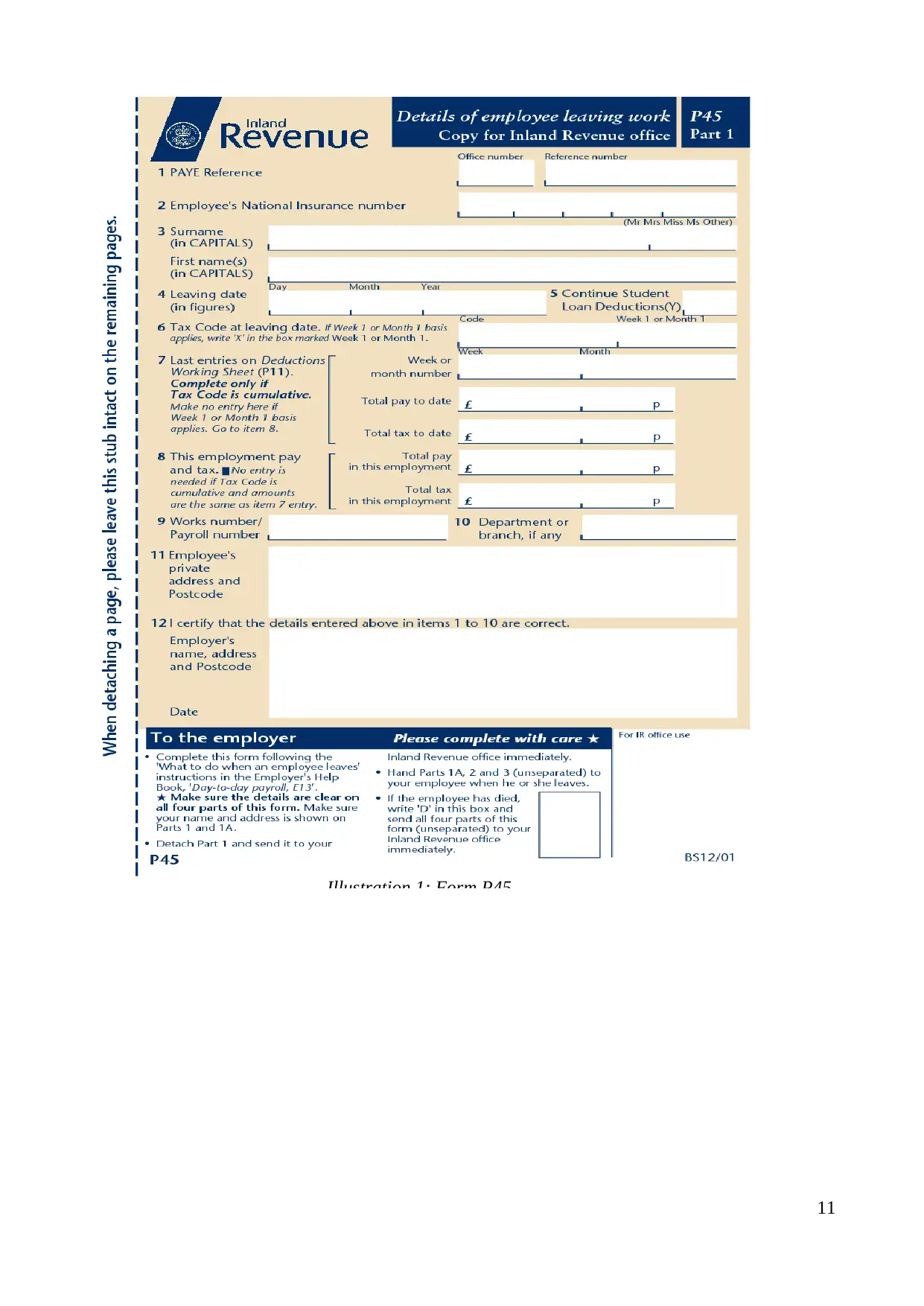
Illustration 1: Form P45
11
11
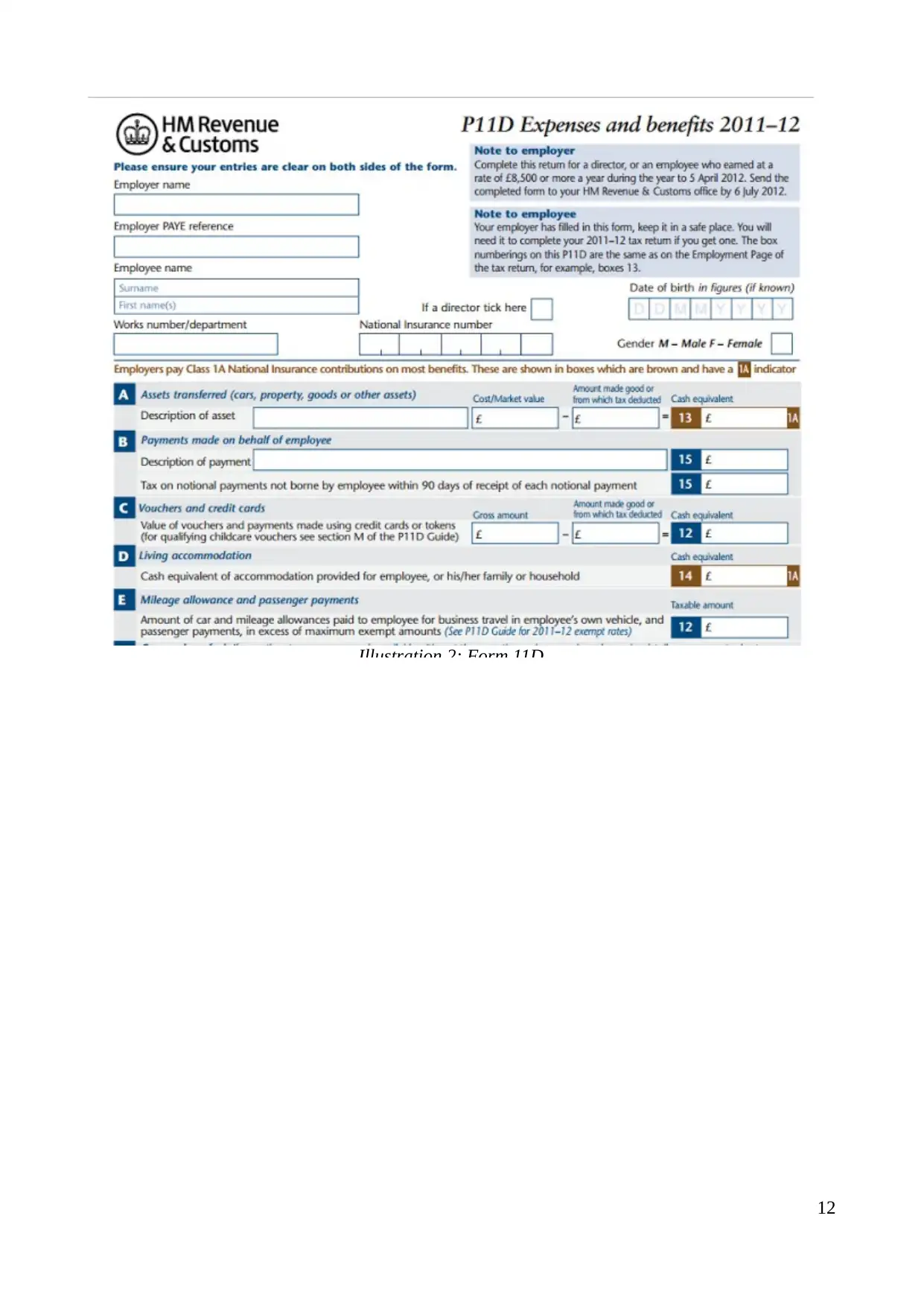
Illustration 2: Form 11D
12
12
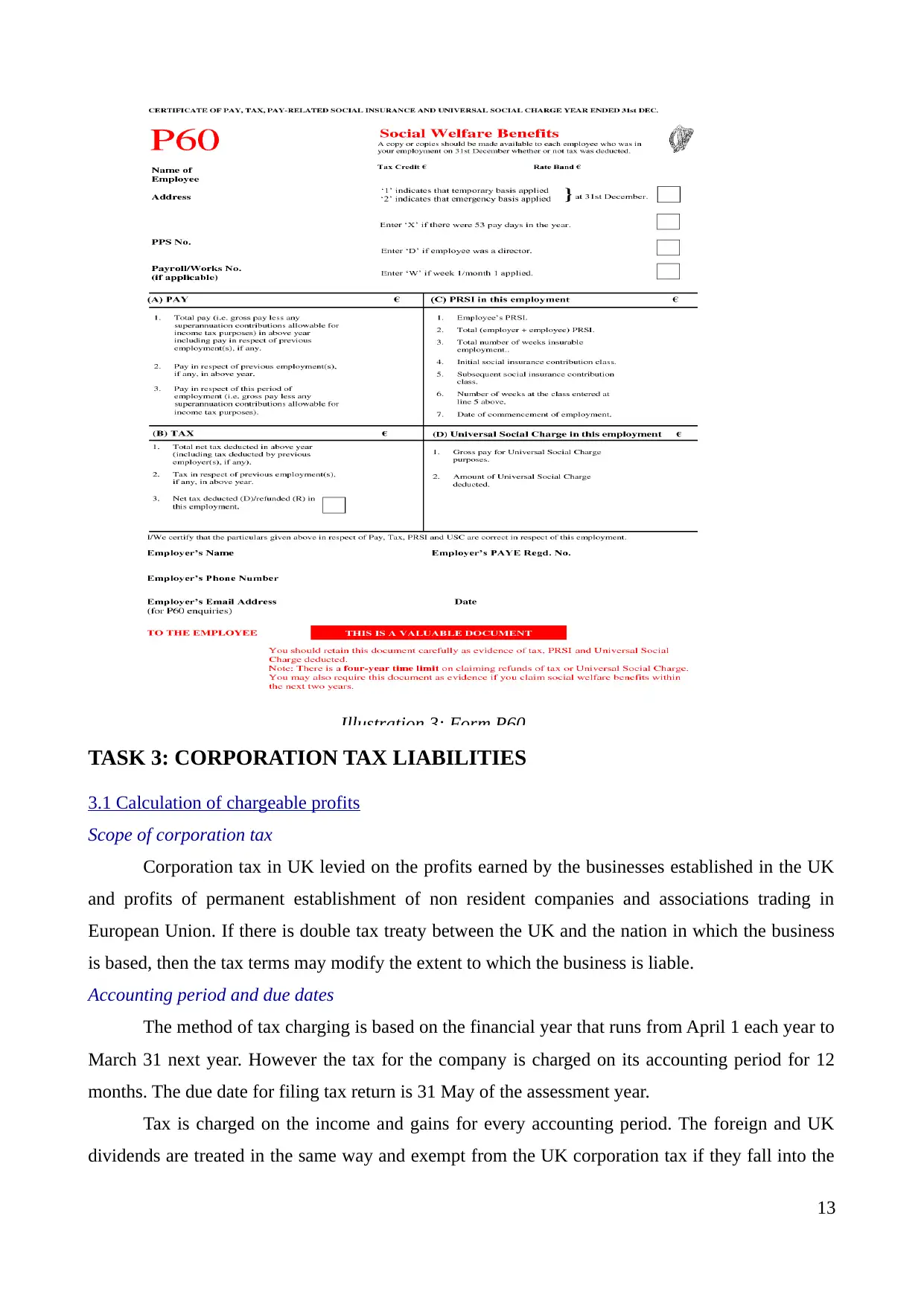
Illustration 3: Form P60
TASK 3: CORPORATION TAX LIABILITIES
3.1 Calculation of chargeable profits
Scope of corporation tax
Corporation tax in UK levied on the profits earned by the businesses established in the UK
and profits of permanent establishment of non resident companies and associations trading in
European Union. If there is double tax treaty between the UK and the nation in which the business
is based, then the tax terms may modify the extent to which the business is liable.
Accounting period and due dates
The method of tax charging is based on the financial year that runs from April 1 each year to
March 31 next year. However the tax for the company is charged on its accounting period for 12
months. The due date for filing tax return is 31 May of the assessment year.
Tax is charged on the income and gains for every accounting period. The foreign and UK
dividends are treated in the same way and exempt from the UK corporation tax if they fall into the
13
TASK 3: CORPORATION TAX LIABILITIES
3.1 Calculation of chargeable profits
Scope of corporation tax
Corporation tax in UK levied on the profits earned by the businesses established in the UK
and profits of permanent establishment of non resident companies and associations trading in
European Union. If there is double tax treaty between the UK and the nation in which the business
is based, then the tax terms may modify the extent to which the business is liable.
Accounting period and due dates
The method of tax charging is based on the financial year that runs from April 1 each year to
March 31 next year. However the tax for the company is charged on its accounting period for 12
months. The due date for filing tax return is 31 May of the assessment year.
Tax is charged on the income and gains for every accounting period. The foreign and UK
dividends are treated in the same way and exempt from the UK corporation tax if they fall into the
13
Paraphrase This Document
Need a fresh take? Get an instant paraphrase of this document with our AI Paraphraser
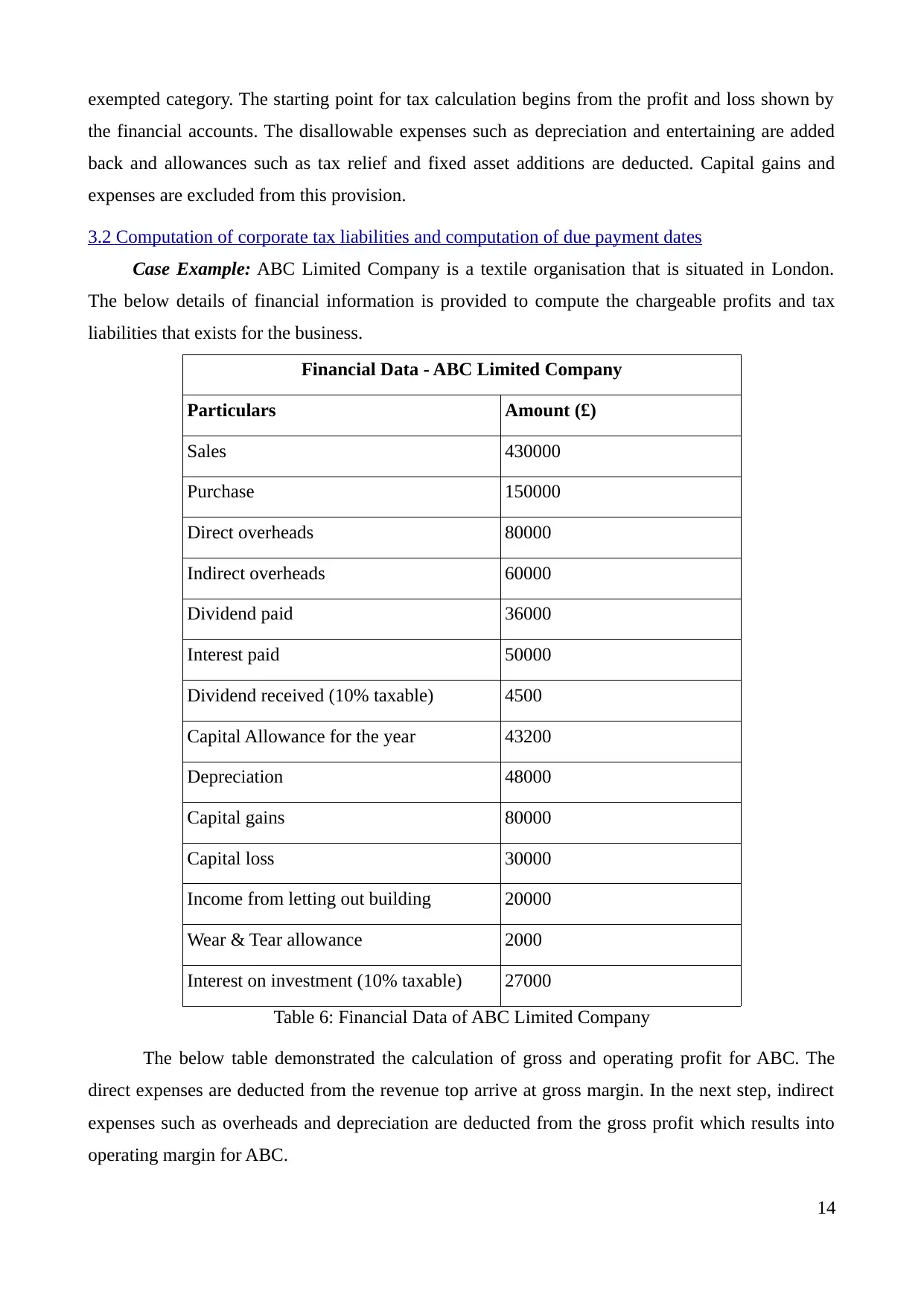
exempted category. The starting point for tax calculation begins from the profit and loss shown by
the financial accounts. The disallowable expenses such as depreciation and entertaining are added
back and allowances such as tax relief and fixed asset additions are deducted. Capital gains and
expenses are excluded from this provision.
3.2 Computation of corporate tax liabilities and computation of due payment dates
Case Example: ABC Limited Company is a textile organisation that is situated in London.
The below details of financial information is provided to compute the chargeable profits and tax
liabilities that exists for the business.
Financial Data - ABC Limited Company
Particulars Amount (£)
Sales 430000
Purchase 150000
Direct overheads 80000
Indirect overheads 60000
Dividend paid 36000
Interest paid 50000
Dividend received (10% taxable) 4500
Capital Allowance for the year 43200
Depreciation 48000
Capital gains 80000
Capital loss 30000
Income from letting out building 20000
Wear & Tear allowance 2000
Interest on investment (10% taxable) 27000
Table 6: Financial Data of ABC Limited Company
The below table demonstrated the calculation of gross and operating profit for ABC. The
direct expenses are deducted from the revenue top arrive at gross margin. In the next step, indirect
expenses such as overheads and depreciation are deducted from the gross profit which results into
operating margin for ABC.
14
the financial accounts. The disallowable expenses such as depreciation and entertaining are added
back and allowances such as tax relief and fixed asset additions are deducted. Capital gains and
expenses are excluded from this provision.
3.2 Computation of corporate tax liabilities and computation of due payment dates
Case Example: ABC Limited Company is a textile organisation that is situated in London.
The below details of financial information is provided to compute the chargeable profits and tax
liabilities that exists for the business.
Financial Data - ABC Limited Company
Particulars Amount (£)
Sales 430000
Purchase 150000
Direct overheads 80000
Indirect overheads 60000
Dividend paid 36000
Interest paid 50000
Dividend received (10% taxable) 4500
Capital Allowance for the year 43200
Depreciation 48000
Capital gains 80000
Capital loss 30000
Income from letting out building 20000
Wear & Tear allowance 2000
Interest on investment (10% taxable) 27000
Table 6: Financial Data of ABC Limited Company
The below table demonstrated the calculation of gross and operating profit for ABC. The
direct expenses are deducted from the revenue top arrive at gross margin. In the next step, indirect
expenses such as overheads and depreciation are deducted from the gross profit which results into
operating margin for ABC.
14
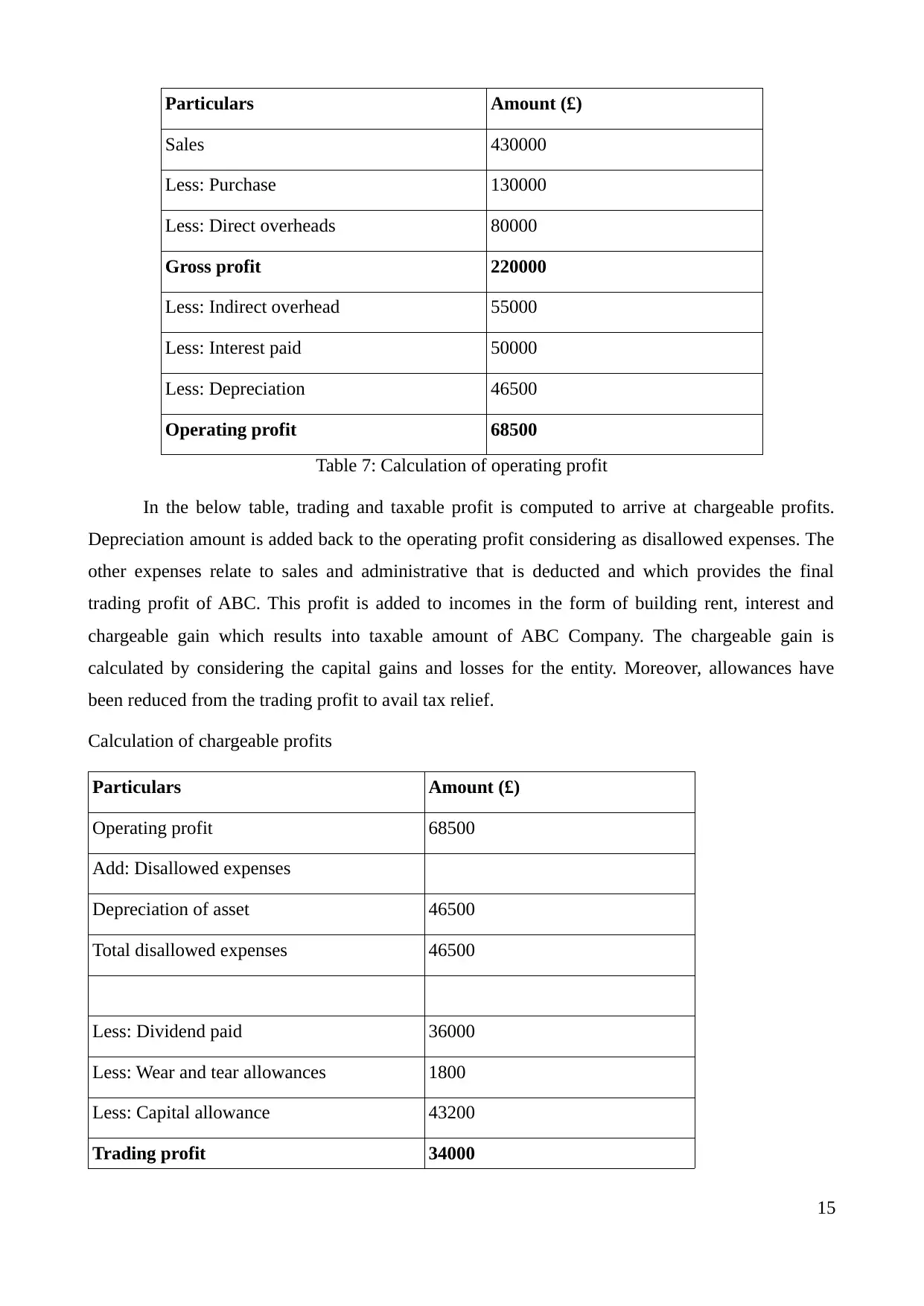
Particulars Amount (£)
Sales 430000
Less: Purchase 130000
Less: Direct overheads 80000
Gross profit 220000
Less: Indirect overhead 55000
Less: Interest paid 50000
Less: Depreciation 46500
Operating profit 68500
Table 7: Calculation of operating profit
In the below table, trading and taxable profit is computed to arrive at chargeable profits.
Depreciation amount is added back to the operating profit considering as disallowed expenses. The
other expenses relate to sales and administrative that is deducted and which provides the final
trading profit of ABC. This profit is added to incomes in the form of building rent, interest and
chargeable gain which results into taxable amount of ABC Company. The chargeable gain is
calculated by considering the capital gains and losses for the entity. Moreover, allowances have
been reduced from the trading profit to avail tax relief.
Calculation of chargeable profits
Particulars Amount (£)
Operating profit 68500
Add: Disallowed expenses
Depreciation of asset 46500
Total disallowed expenses 46500
Less: Dividend paid 36000
Less: Wear and tear allowances 1800
Less: Capital allowance 43200
Trading profit 34000
15
Sales 430000
Less: Purchase 130000
Less: Direct overheads 80000
Gross profit 220000
Less: Indirect overhead 55000
Less: Interest paid 50000
Less: Depreciation 46500
Operating profit 68500
Table 7: Calculation of operating profit
In the below table, trading and taxable profit is computed to arrive at chargeable profits.
Depreciation amount is added back to the operating profit considering as disallowed expenses. The
other expenses relate to sales and administrative that is deducted and which provides the final
trading profit of ABC. This profit is added to incomes in the form of building rent, interest and
chargeable gain which results into taxable amount of ABC Company. The chargeable gain is
calculated by considering the capital gains and losses for the entity. Moreover, allowances have
been reduced from the trading profit to avail tax relief.
Calculation of chargeable profits
Particulars Amount (£)
Operating profit 68500
Add: Disallowed expenses
Depreciation of asset 46500
Total disallowed expenses 46500
Less: Dividend paid 36000
Less: Wear and tear allowances 1800
Less: Capital allowance 43200
Trading profit 34000
15
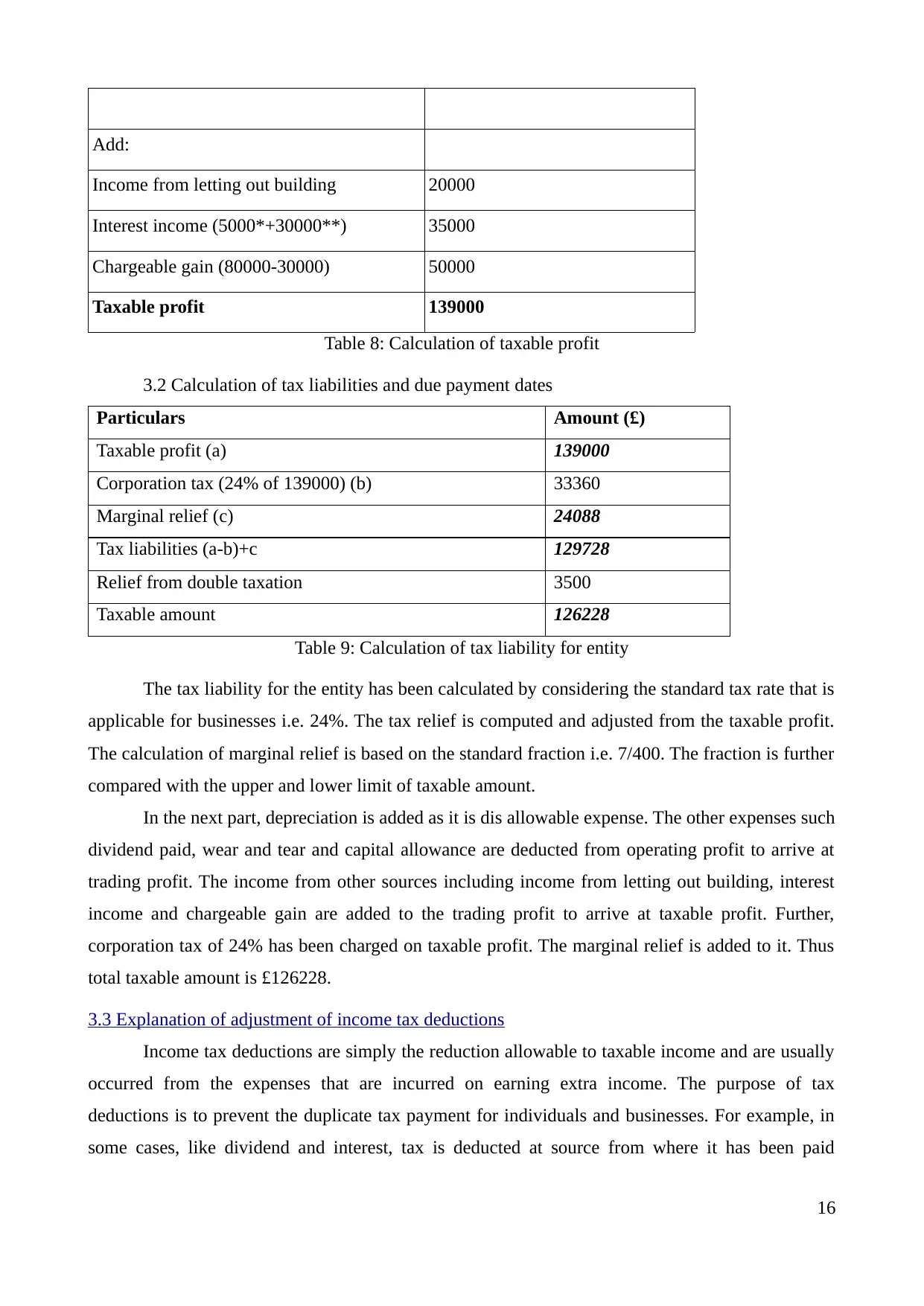
Add:
Income from letting out building 20000
Interest income (5000*+30000**) 35000
Chargeable gain (80000-30000) 50000
Taxable profit 139000
Table 8: Calculation of taxable profit
3.2 Calculation of tax liabilities and due payment dates
Particulars Amount (£)
Taxable profit (a) 139000
Corporation tax (24% of 139000) (b) 33360
Marginal relief (c) 24088
Tax liabilities (a-b)+c 129728
Relief from double taxation 3500
Taxable amount 126228
Table 9: Calculation of tax liability for entity
The tax liability for the entity has been calculated by considering the standard tax rate that is
applicable for businesses i.e. 24%. The tax relief is computed and adjusted from the taxable profit.
The calculation of marginal relief is based on the standard fraction i.e. 7/400. The fraction is further
compared with the upper and lower limit of taxable amount.
In the next part, depreciation is added as it is dis allowable expense. The other expenses such
dividend paid, wear and tear and capital allowance are deducted from operating profit to arrive at
trading profit. The income from other sources including income from letting out building, interest
income and chargeable gain are added to the trading profit to arrive at taxable profit. Further,
corporation tax of 24% has been charged on taxable profit. The marginal relief is added to it. Thus
total taxable amount is £126228.
3.3 Explanation of adjustment of income tax deductions
Income tax deductions are simply the reduction allowable to taxable income and are usually
occurred from the expenses that are incurred on earning extra income. The purpose of tax
deductions is to prevent the duplicate tax payment for individuals and businesses. For example, in
some cases, like dividend and interest, tax is deducted at source from where it has been paid
16
Income from letting out building 20000
Interest income (5000*+30000**) 35000
Chargeable gain (80000-30000) 50000
Taxable profit 139000
Table 8: Calculation of taxable profit
3.2 Calculation of tax liabilities and due payment dates
Particulars Amount (£)
Taxable profit (a) 139000
Corporation tax (24% of 139000) (b) 33360
Marginal relief (c) 24088
Tax liabilities (a-b)+c 129728
Relief from double taxation 3500
Taxable amount 126228
Table 9: Calculation of tax liability for entity
The tax liability for the entity has been calculated by considering the standard tax rate that is
applicable for businesses i.e. 24%. The tax relief is computed and adjusted from the taxable profit.
The calculation of marginal relief is based on the standard fraction i.e. 7/400. The fraction is further
compared with the upper and lower limit of taxable amount.
In the next part, depreciation is added as it is dis allowable expense. The other expenses such
dividend paid, wear and tear and capital allowance are deducted from operating profit to arrive at
trading profit. The income from other sources including income from letting out building, interest
income and chargeable gain are added to the trading profit to arrive at taxable profit. Further,
corporation tax of 24% has been charged on taxable profit. The marginal relief is added to it. Thus
total taxable amount is £126228.
3.3 Explanation of adjustment of income tax deductions
Income tax deductions are simply the reduction allowable to taxable income and are usually
occurred from the expenses that are incurred on earning extra income. The purpose of tax
deductions is to prevent the duplicate tax payment for individuals and businesses. For example, in
some cases, like dividend and interest, tax is deducted at source from where it has been paid
16
Secure Best Marks with AI Grader
Need help grading? Try our AI Grader for instant feedback on your assignments.
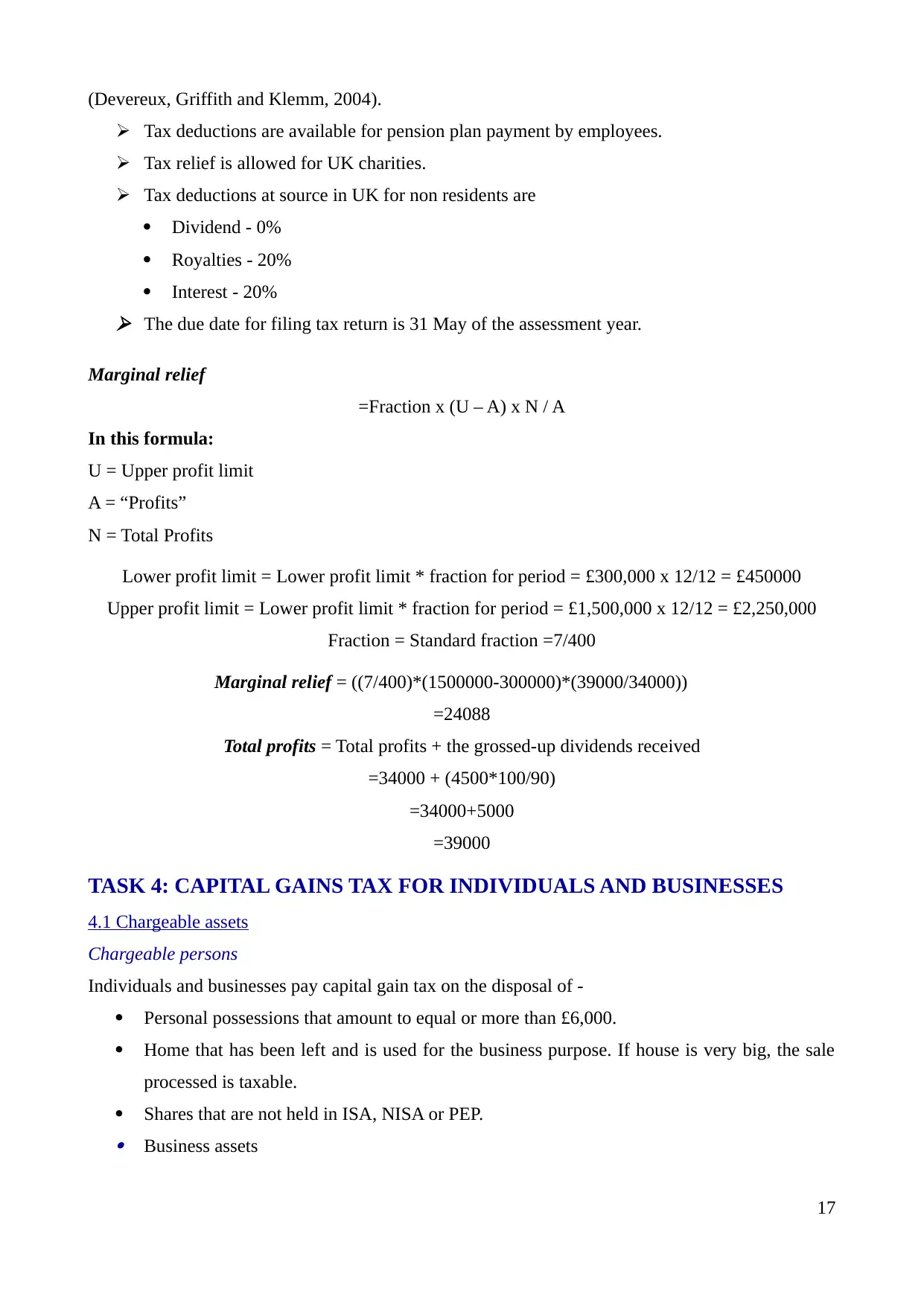
(Devereux, Griffith and Klemm, 2004).
Tax deductions are available for pension plan payment by employees.
Tax relief is allowed for UK charities.
Tax deductions at source in UK for non residents are
Dividend - 0%
Royalties - 20%
Interest - 20% The due date for filing tax return is 31 May of the assessment year.
Marginal relief
=Fraction x (U – A) x N / A
In this formula:
U = Upper profit limit
A = “Profits”
N = Total Profits
Lower profit limit = Lower profit limit * fraction for period = £300,000 x 12/12 = £450000
Upper profit limit = Lower profit limit * fraction for period = £1,500,000 x 12/12 = £2,250,000
Fraction = Standard fraction =7/400
Marginal relief = ((7/400)*(1500000-300000)*(39000/34000))
=24088
Total profits = Total profits + the grossed-up dividends received
=34000 + (4500*100/90)
=34000+5000
=39000
TASK 4: CAPITAL GAINS TAX FOR INDIVIDUALS AND BUSINESSES
4.1 Chargeable assets
Chargeable persons
Individuals and businesses pay capital gain tax on the disposal of -
Personal possessions that amount to equal or more than £6,000.
Home that has been left and is used for the business purpose. If house is very big, the sale
processed is taxable.
Shares that are not held in ISA, NISA or PEP. Business assets
17
Tax deductions are available for pension plan payment by employees.
Tax relief is allowed for UK charities.
Tax deductions at source in UK for non residents are
Dividend - 0%
Royalties - 20%
Interest - 20% The due date for filing tax return is 31 May of the assessment year.
Marginal relief
=Fraction x (U – A) x N / A
In this formula:
U = Upper profit limit
A = “Profits”
N = Total Profits
Lower profit limit = Lower profit limit * fraction for period = £300,000 x 12/12 = £450000
Upper profit limit = Lower profit limit * fraction for period = £1,500,000 x 12/12 = £2,250,000
Fraction = Standard fraction =7/400
Marginal relief = ((7/400)*(1500000-300000)*(39000/34000))
=24088
Total profits = Total profits + the grossed-up dividends received
=34000 + (4500*100/90)
=34000+5000
=39000
TASK 4: CAPITAL GAINS TAX FOR INDIVIDUALS AND BUSINESSES
4.1 Chargeable assets
Chargeable persons
Individuals and businesses pay capital gain tax on the disposal of -
Personal possessions that amount to equal or more than £6,000.
Home that has been left and is used for the business purpose. If house is very big, the sale
processed is taxable.
Shares that are not held in ISA, NISA or PEP. Business assets
17
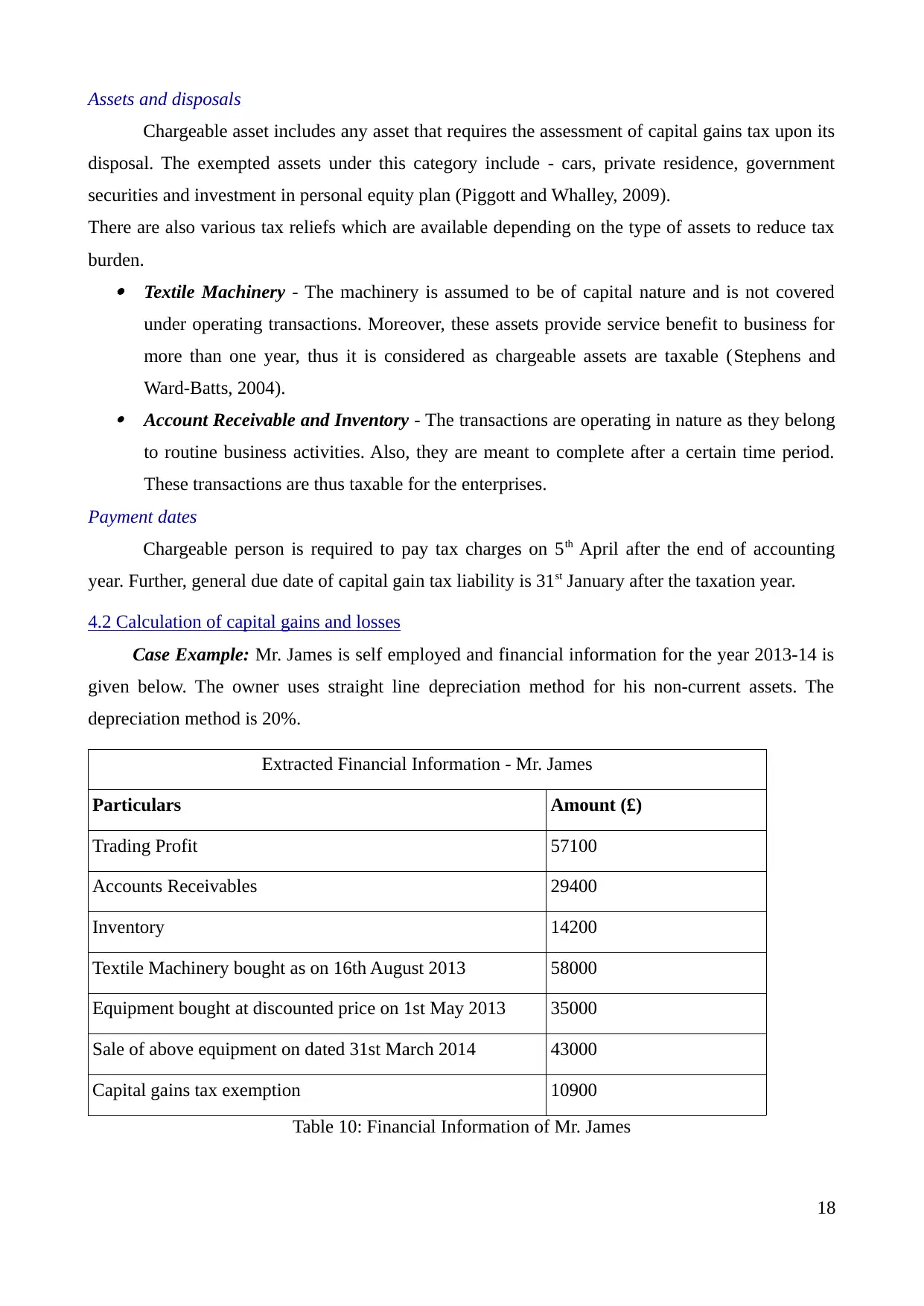
Assets and disposals
Chargeable asset includes any asset that requires the assessment of capital gains tax upon its
disposal. The exempted assets under this category include - cars, private residence, government
securities and investment in personal equity plan (Piggott and Whalley, 2009).
There are also various tax reliefs which are available depending on the type of assets to reduce tax
burden. Textile Machinery - The machinery is assumed to be of capital nature and is not covered
under operating transactions. Moreover, these assets provide service benefit to business for
more than one year, thus it is considered as chargeable assets are taxable (Stephens and
Ward-Batts, 2004). Account Receivable and Inventory - The transactions are operating in nature as they belong
to routine business activities. Also, they are meant to complete after a certain time period.
These transactions are thus taxable for the enterprises.
Payment dates
Chargeable person is required to pay tax charges on 5th April after the end of accounting
year. Further, general due date of capital gain tax liability is 31st January after the taxation year.
4.2 Calculation of capital gains and losses
Case Example: Mr. James is self employed and financial information for the year 2013-14 is
given below. The owner uses straight line depreciation method for his non-current assets. The
depreciation method is 20%.
Extracted Financial Information - Mr. James
Particulars Amount (£)
Trading Profit 57100
Accounts Receivables 29400
Inventory 14200
Textile Machinery bought as on 16th August 2013 58000
Equipment bought at discounted price on 1st May 2013 35000
Sale of above equipment on dated 31st March 2014 43000
Capital gains tax exemption 10900
Table 10: Financial Information of Mr. James
18
Chargeable asset includes any asset that requires the assessment of capital gains tax upon its
disposal. The exempted assets under this category include - cars, private residence, government
securities and investment in personal equity plan (Piggott and Whalley, 2009).
There are also various tax reliefs which are available depending on the type of assets to reduce tax
burden. Textile Machinery - The machinery is assumed to be of capital nature and is not covered
under operating transactions. Moreover, these assets provide service benefit to business for
more than one year, thus it is considered as chargeable assets are taxable (Stephens and
Ward-Batts, 2004). Account Receivable and Inventory - The transactions are operating in nature as they belong
to routine business activities. Also, they are meant to complete after a certain time period.
These transactions are thus taxable for the enterprises.
Payment dates
Chargeable person is required to pay tax charges on 5th April after the end of accounting
year. Further, general due date of capital gain tax liability is 31st January after the taxation year.
4.2 Calculation of capital gains and losses
Case Example: Mr. James is self employed and financial information for the year 2013-14 is
given below. The owner uses straight line depreciation method for his non-current assets. The
depreciation method is 20%.
Extracted Financial Information - Mr. James
Particulars Amount (£)
Trading Profit 57100
Accounts Receivables 29400
Inventory 14200
Textile Machinery bought as on 16th August 2013 58000
Equipment bought at discounted price on 1st May 2013 35000
Sale of above equipment on dated 31st March 2014 43000
Capital gains tax exemption 10900
Table 10: Financial Information of Mr. James
18
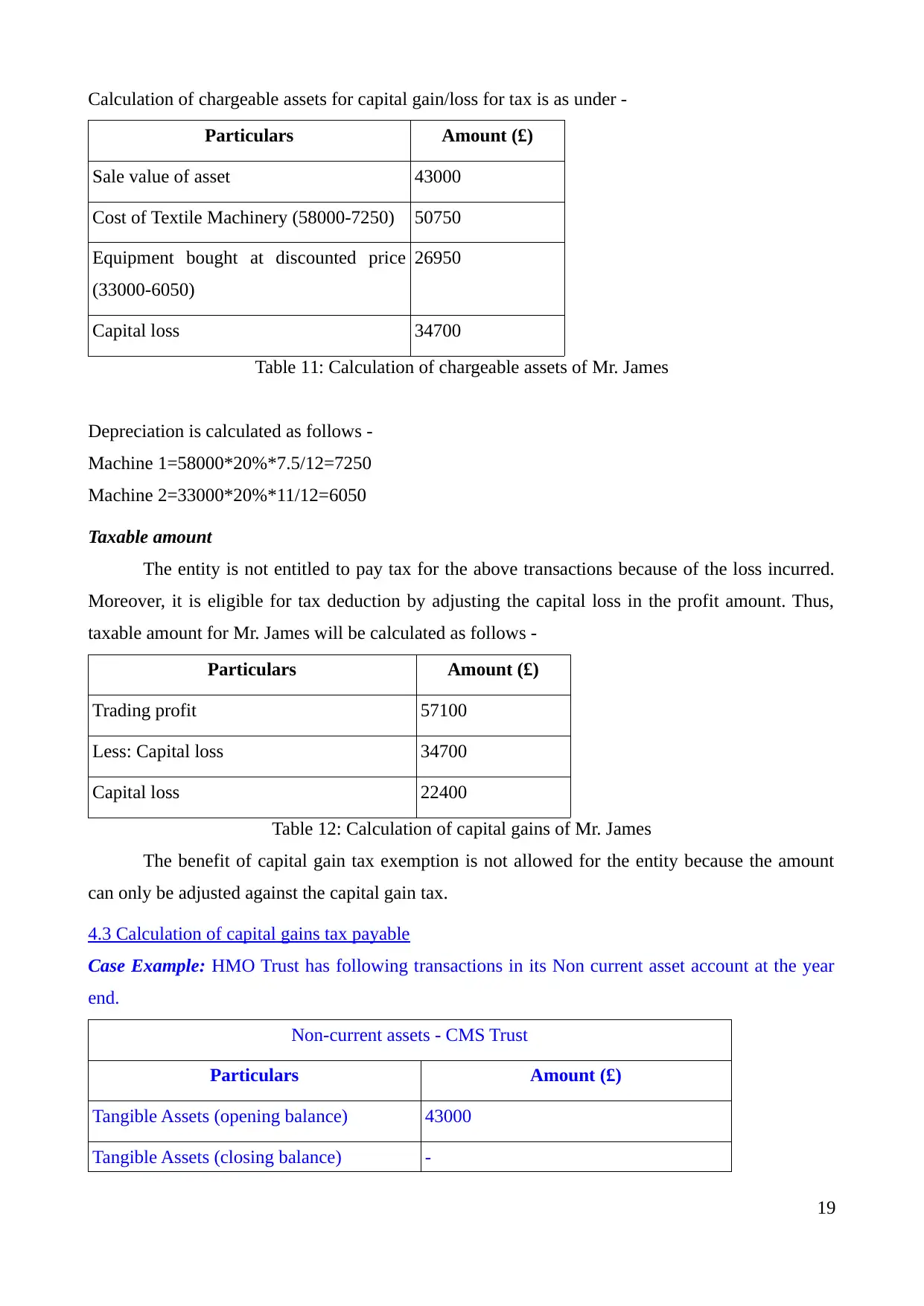
Calculation of chargeable assets for capital gain/loss for tax is as under -
Particulars Amount (£)
Sale value of asset 43000
Cost of Textile Machinery (58000-7250) 50750
Equipment bought at discounted price
(33000-6050)
26950
Capital loss 34700
Table 11: Calculation of chargeable assets of Mr. James
Depreciation is calculated as follows -
Machine 1=58000*20%*7.5/12=7250
Machine 2=33000*20%*11/12=6050
Taxable amount
The entity is not entitled to pay tax for the above transactions because of the loss incurred.
Moreover, it is eligible for tax deduction by adjusting the capital loss in the profit amount. Thus,
taxable amount for Mr. James will be calculated as follows -
Particulars Amount (£)
Trading profit 57100
Less: Capital loss 34700
Capital loss 22400
Table 12: Calculation of capital gains of Mr. James
The benefit of capital gain tax exemption is not allowed for the entity because the amount
can only be adjusted against the capital gain tax.
4.3 Calculation of capital gains tax payable
Case Example: HMO Trust has following transactions in its Non current asset account at the year
end.
Non-current assets - CMS Trust
Particulars Amount (£)
Tangible Assets (opening balance) 43000
Tangible Assets (closing balance) -
19
Particulars Amount (£)
Sale value of asset 43000
Cost of Textile Machinery (58000-7250) 50750
Equipment bought at discounted price
(33000-6050)
26950
Capital loss 34700
Table 11: Calculation of chargeable assets of Mr. James
Depreciation is calculated as follows -
Machine 1=58000*20%*7.5/12=7250
Machine 2=33000*20%*11/12=6050
Taxable amount
The entity is not entitled to pay tax for the above transactions because of the loss incurred.
Moreover, it is eligible for tax deduction by adjusting the capital loss in the profit amount. Thus,
taxable amount for Mr. James will be calculated as follows -
Particulars Amount (£)
Trading profit 57100
Less: Capital loss 34700
Capital loss 22400
Table 12: Calculation of capital gains of Mr. James
The benefit of capital gain tax exemption is not allowed for the entity because the amount
can only be adjusted against the capital gain tax.
4.3 Calculation of capital gains tax payable
Case Example: HMO Trust has following transactions in its Non current asset account at the year
end.
Non-current assets - CMS Trust
Particulars Amount (£)
Tangible Assets (opening balance) 43000
Tangible Assets (closing balance) -
19
Paraphrase This Document
Need a fresh take? Get an instant paraphrase of this document with our AI Paraphraser
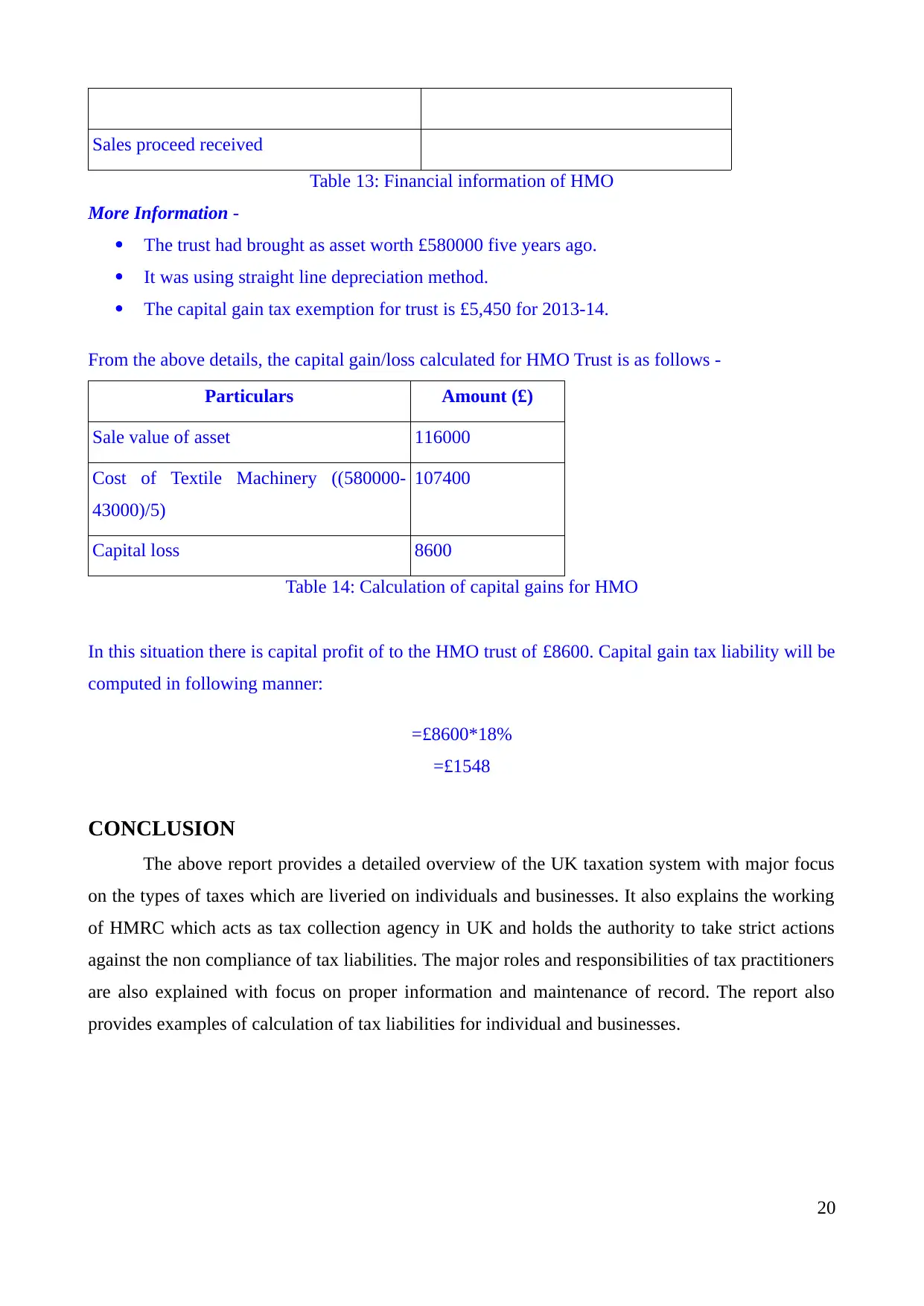
Sales proceed received
Table 13: Financial information of HMO
More Information -
The trust had brought as asset worth £580000 five years ago.
It was using straight line depreciation method.
The capital gain tax exemption for trust is £5,450 for 2013-14.
From the above details, the capital gain/loss calculated for HMO Trust is as follows -
Particulars Amount (£)
Sale value of asset 116000
Cost of Textile Machinery ((580000-
43000)/5)
107400
Capital loss 8600
Table 14: Calculation of capital gains for HMO
In this situation there is capital profit of to the HMO trust of £8600. Capital gain tax liability will be
computed in following manner:
=£8600*18%
=£1548
CONCLUSION
The above report provides a detailed overview of the UK taxation system with major focus
on the types of taxes which are liveried on individuals and businesses. It also explains the working
of HMRC which acts as tax collection agency in UK and holds the authority to take strict actions
against the non compliance of tax liabilities. The major roles and responsibilities of tax practitioners
are also explained with focus on proper information and maintenance of record. The report also
provides examples of calculation of tax liabilities for individual and businesses.
20
Table 13: Financial information of HMO
More Information -
The trust had brought as asset worth £580000 five years ago.
It was using straight line depreciation method.
The capital gain tax exemption for trust is £5,450 for 2013-14.
From the above details, the capital gain/loss calculated for HMO Trust is as follows -
Particulars Amount (£)
Sale value of asset 116000
Cost of Textile Machinery ((580000-
43000)/5)
107400
Capital loss 8600
Table 14: Calculation of capital gains for HMO
In this situation there is capital profit of to the HMO trust of £8600. Capital gain tax liability will be
computed in following manner:
=£8600*18%
=£1548
CONCLUSION
The above report provides a detailed overview of the UK taxation system with major focus
on the types of taxes which are liveried on individuals and businesses. It also explains the working
of HMRC which acts as tax collection agency in UK and holds the authority to take strict actions
against the non compliance of tax liabilities. The major roles and responsibilities of tax practitioners
are also explained with focus on proper information and maintenance of record. The report also
provides examples of calculation of tax liabilities for individual and businesses.
20
1 out of 20
Related Documents
Your All-in-One AI-Powered Toolkit for Academic Success.
+13062052269
info@desklib.com
Available 24*7 on WhatsApp / Email
![[object Object]](/_next/static/media/star-bottom.7253800d.svg)
Unlock your academic potential
© 2024 | Zucol Services PVT LTD | All rights reserved.





